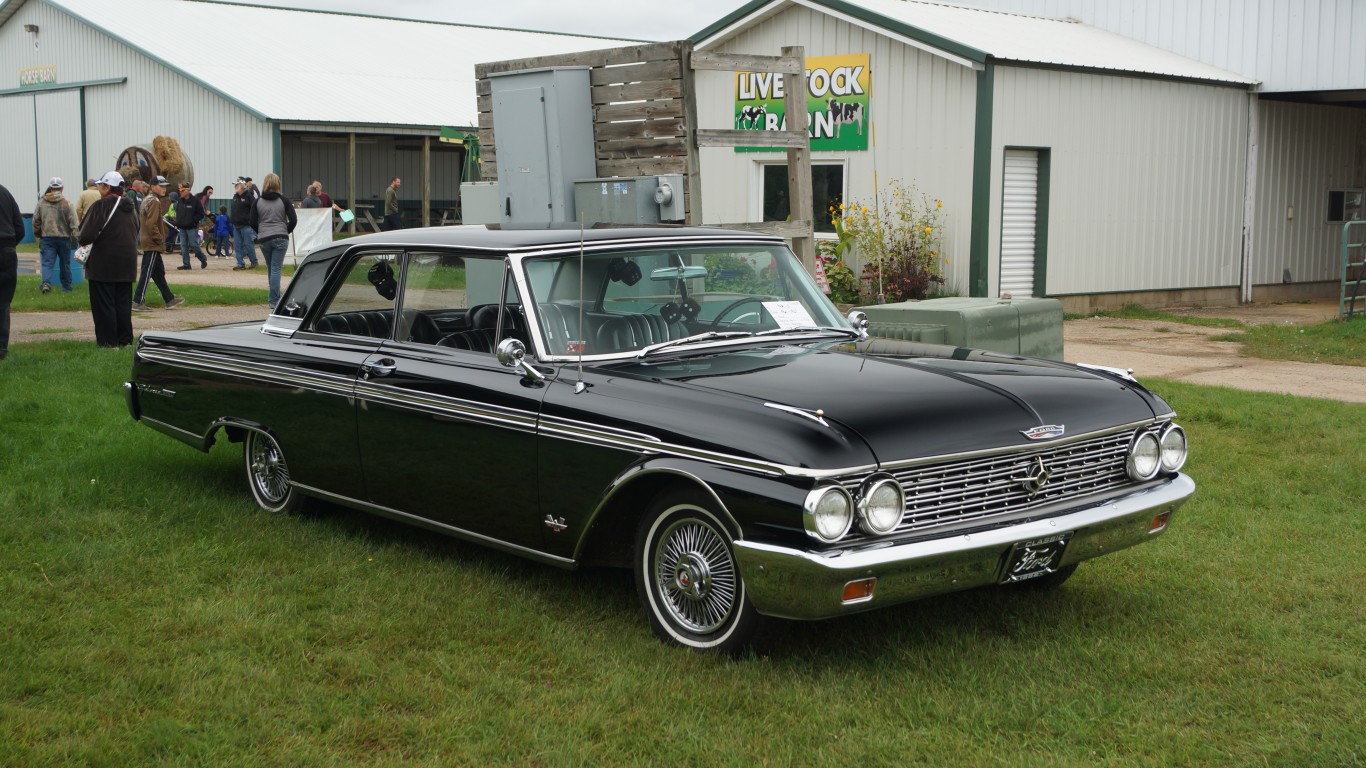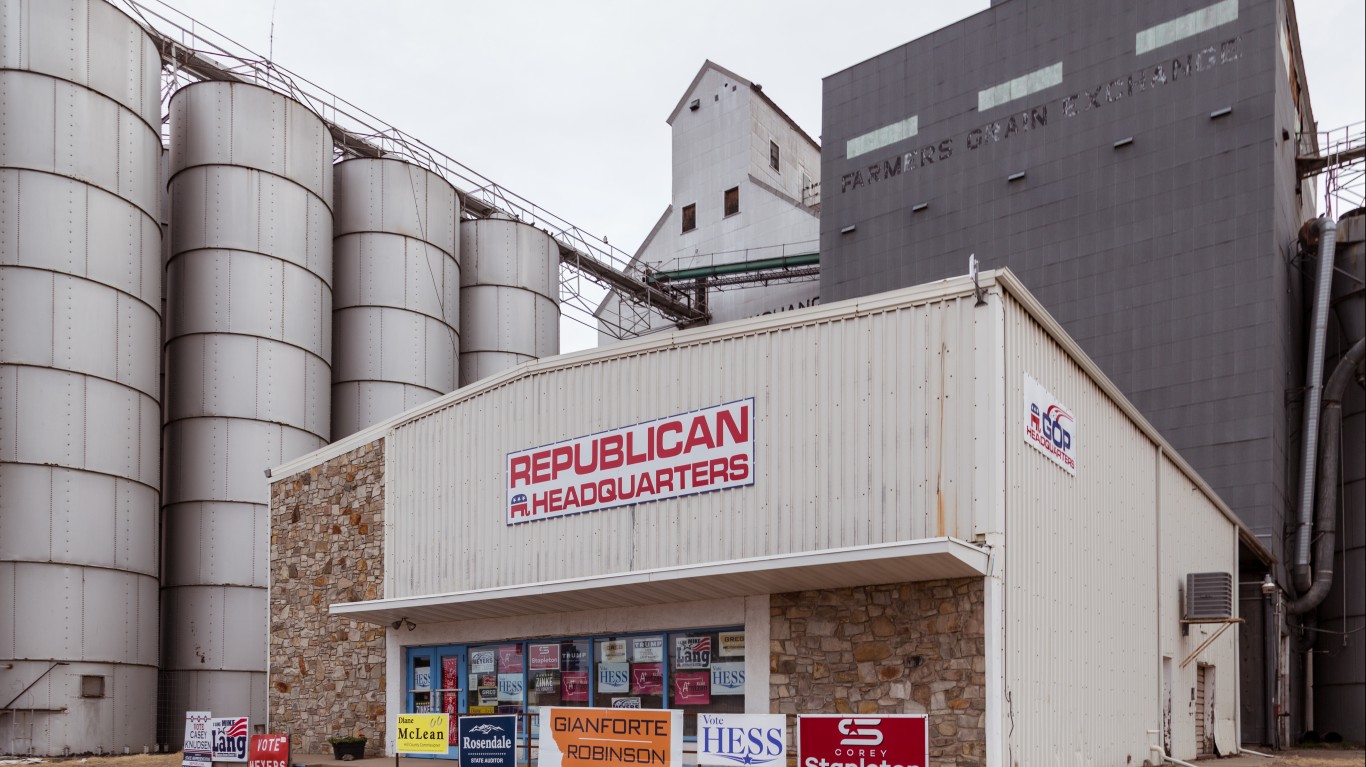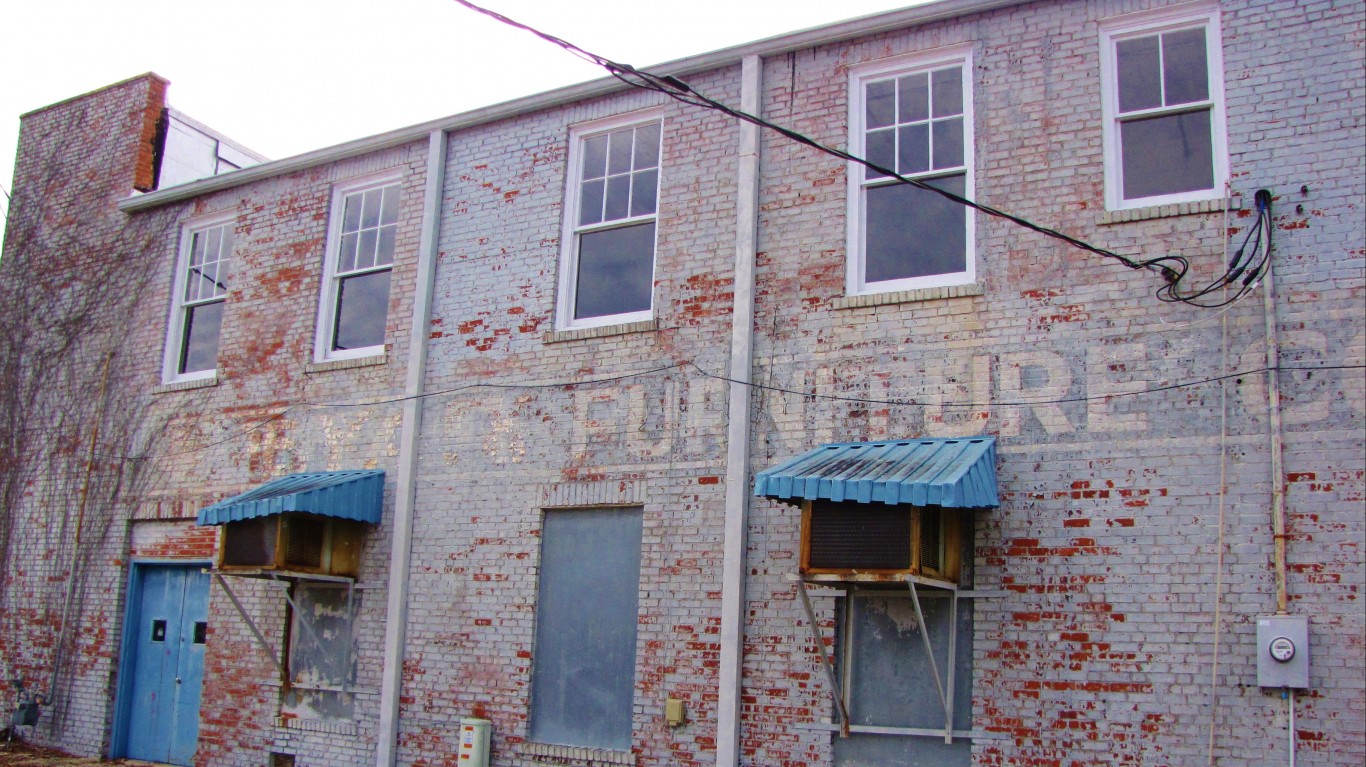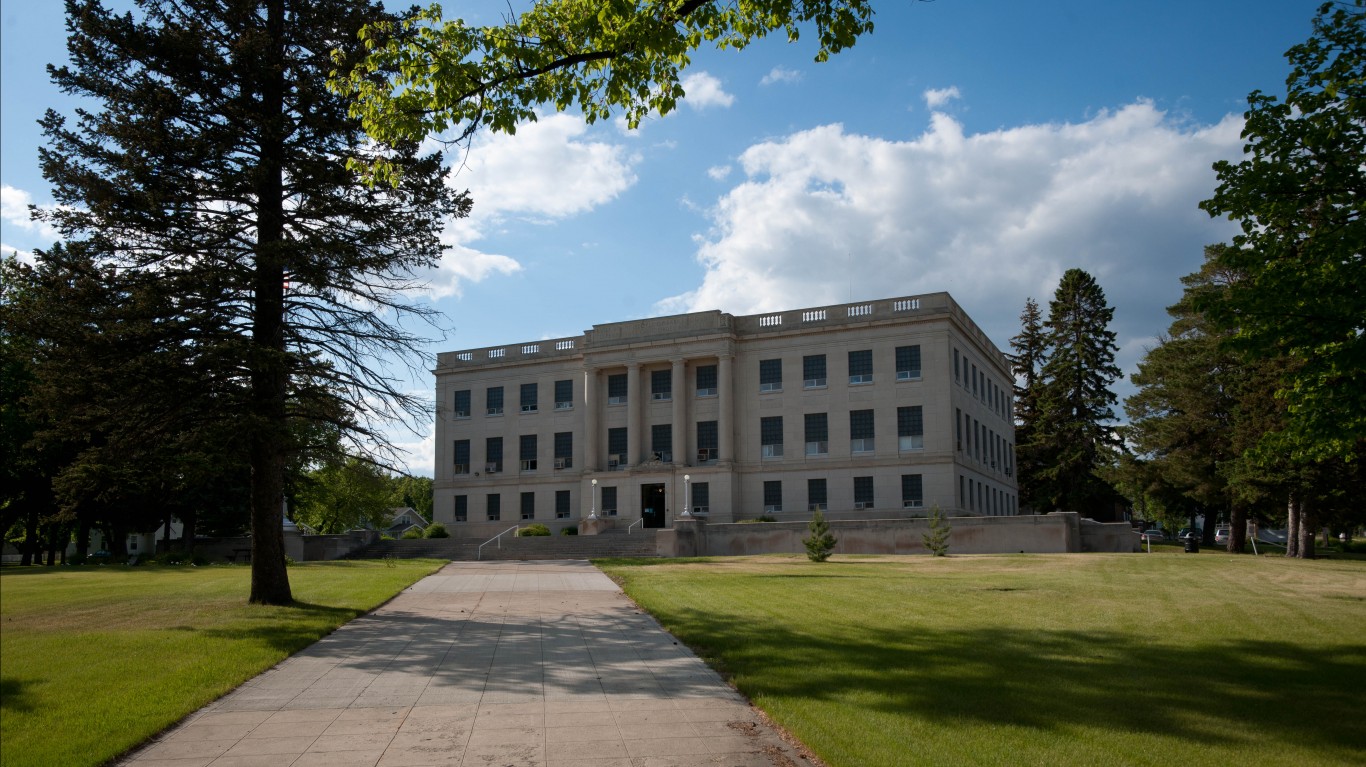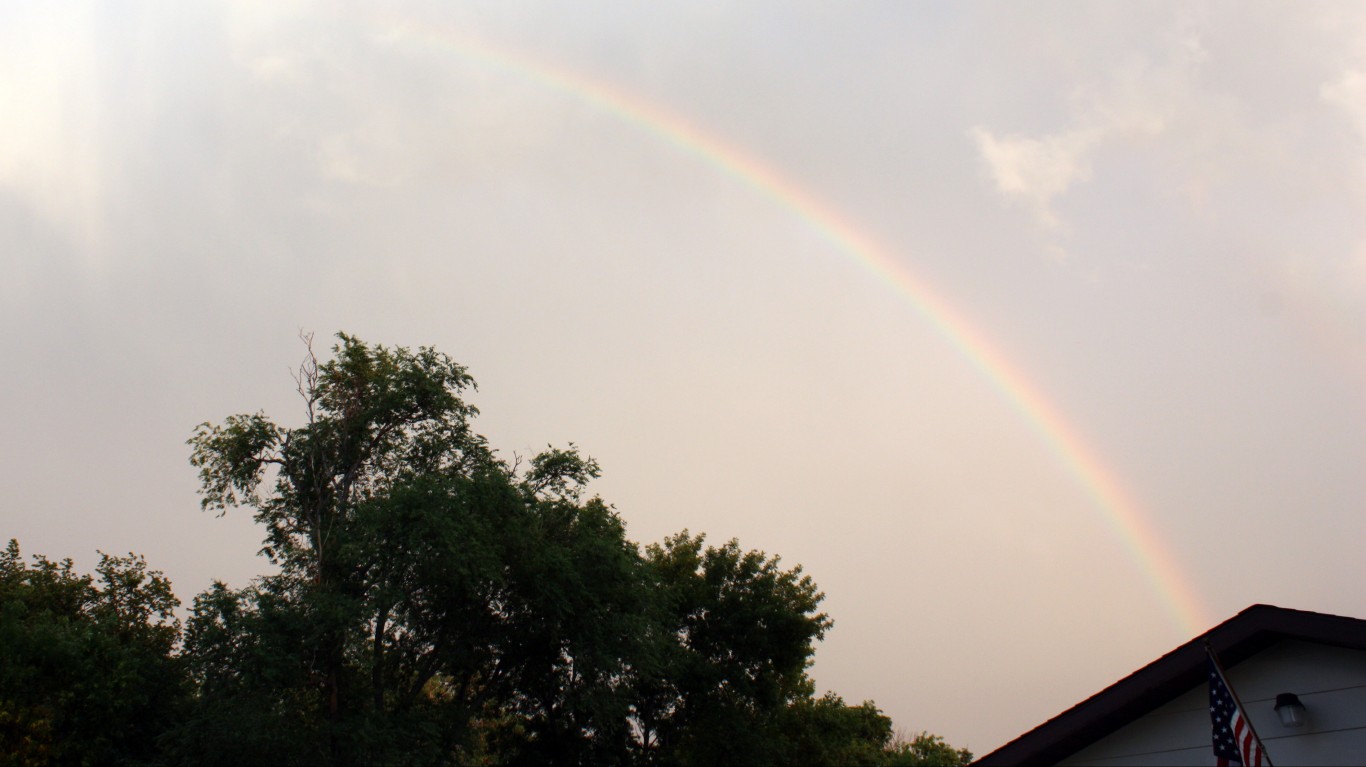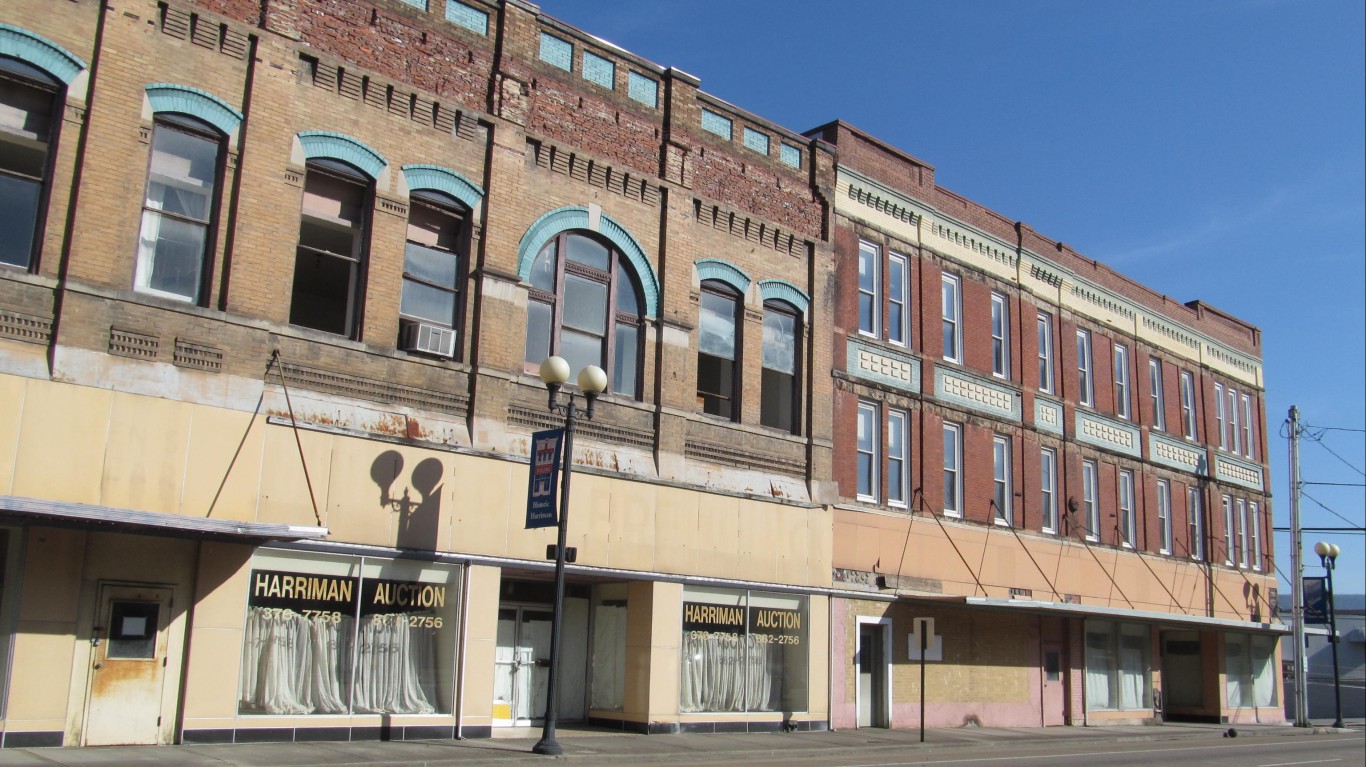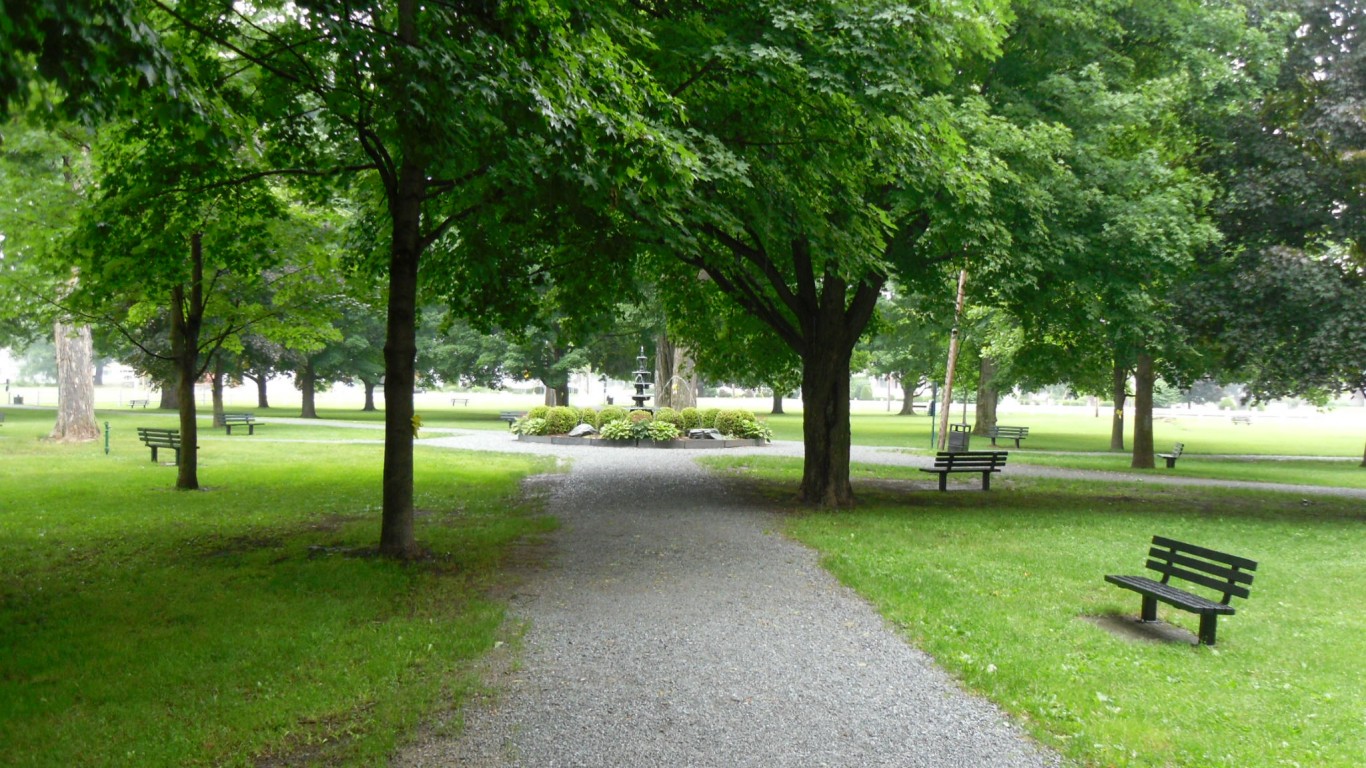
Addressing the Senate Banking Committee earlier this week, Federal Reserve Chairman Jerome Powell testified that a full economic recovery in the wake of the pandemic is uncertain. As CARES act unemployment benefits are set to expire next month, and as federal lawmakers have yet to agree on a new round of stimulus, Powell’s remarks offer little consolation for the nearly 40 million Americans who have filed for unemployment since mid-March. Here is a look at every state’s unemployment claims since COVID-19 shut the economy down.
The new economic reality of reduced income — and even poverty — for many Americans is already all too familiar in many parts of the United States. For decades, small towns and cities across the country have been devastated by deindustrialization and job losses. In these places, incomes are generally low, poverty rates are high, and many residents depend on government assistance, like SNAP (food stamps), to afford basic necessities.
In nearly every state, even relatively wealthy states, there is at least one town where incomes are far lower than the median nationwide. 24/7 Wall St. reviewed the median annual household income in over 2,600 cities, towns, villages, and Census designated places to identify the poorest town in every state.
We only considered areas with populations between 1,000 and 25,000. To ensure accuracy, we only considered places where the margin of error for population and median household income was less than 10%. All data on income, education, poverty, and demographics are five-year estimates from the U.S. Census Bureau’s 2018 American Community Survey.
One of the strongest correlations with income in the United States is education. According to the Bureau of Labor Statistics, Americans with a bachelor’s degree are far less likely to be unemployed than Americans with lower education, and they earn 67% more than those with only a high school diploma. Nationwide, 31.5% of adults have a bachelor’s degree. In the vast majority of places on this list, less than 20% do. Here is a look at the most educated city in every state.
Click here to see the poorest town in every state
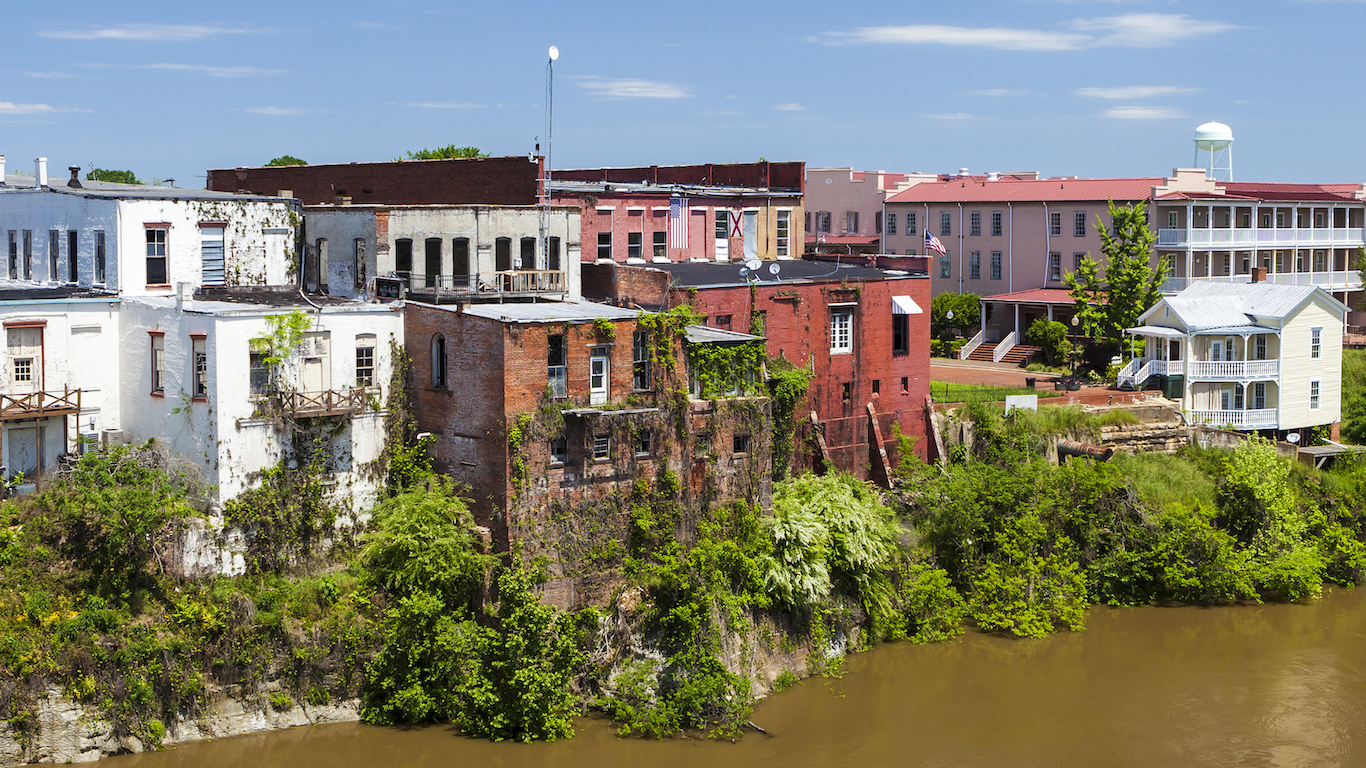
Alabama: Selma
> Median household income: $24,820 (state: $48,486)
> Poverty rate: 41.0% (state: 17.5%)
> Median home value: $90,200 (state: $137,200)
> Population: 18,804
Selma, a small central Alabama city of about 19,000 people, ranks as the poorest place in the state. The typical Selma household earns just $24,820 a year, only about half the median household income of $48,486 across the state. Lack of economic opportunity in the area may be pushing people out. Over the last five years, Selma’s population fell by nearly 8%.
Black Americans are more than twice as likely as white Americans to live in poverty in the United States, and more than 80% of the city’s residents are black, one of the highest shares of any place in the state.

Alaska: Ketchikan
> Median household income: $59,132 (state: $76,715)
> Poverty rate: 12.6% (state: 10.8%)
> Median home value: $237,700 (state: $265,200)
> Population: 8,224
Alaska is one of the states with the highest household incomes in the country. The typical Alaskan household earns nearly $77,000 per year, $16,000 more than the typical American household nationwide. Even in Ketchikan, the poorest place in the state, the typical household earns $59,132 a year, in line with the median household income nationwide of $60,293.
Ketchikan residents are also less likely to live below the poverty line than most Americans. The city’s 12.6% poverty rate is slightly lower than the comparable 14.1% national poverty rate.
[in-text-ad]
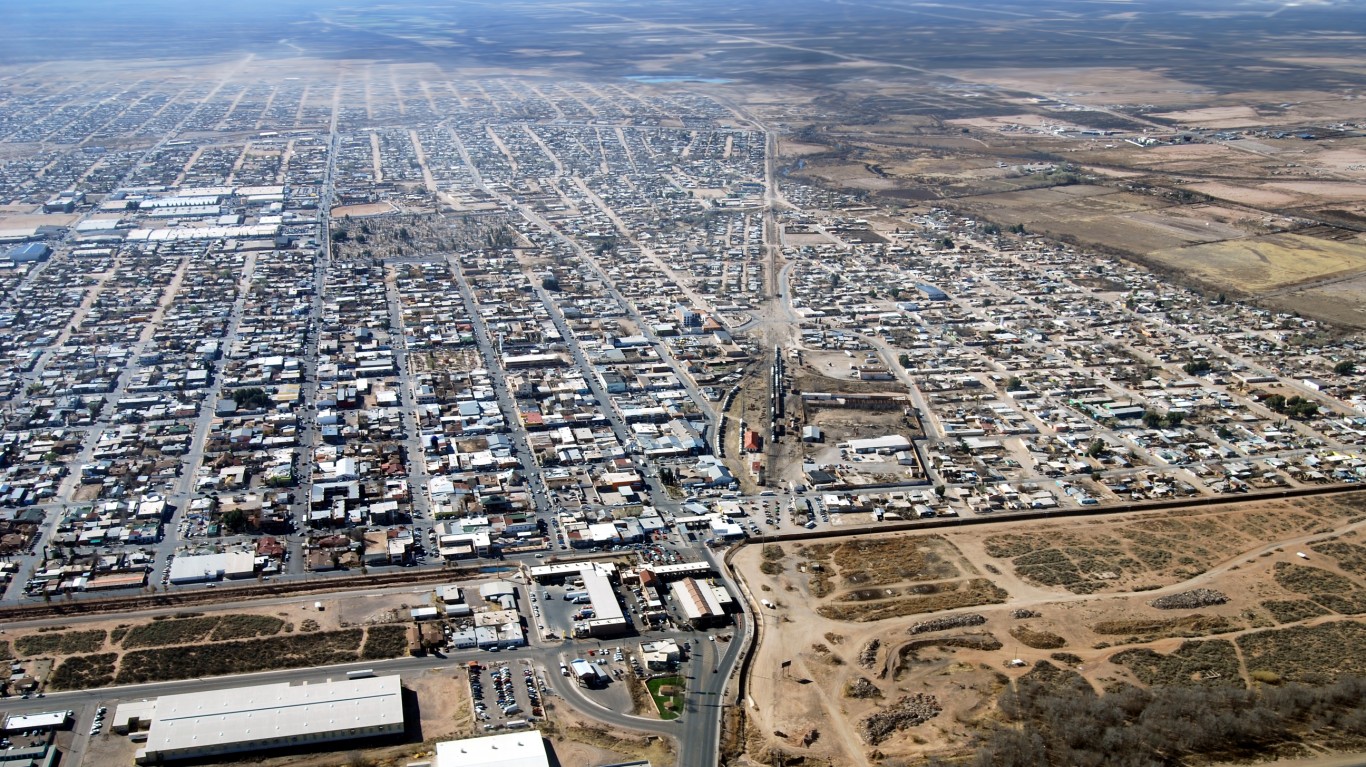
Arizona: Douglas
> Median household income: $34,154 (state: $56,213)
> Poverty rate: 29.3% (state: 16.1%)
> Median home value: $94,500 (state: $209,600)
> Population: 16,453
Douglas is a small city of about 16,500 in southern Arizona along the U.S.-Mexico border. The majority of households in Douglas earn less than $35,000 a year. Meanwhile, across Arizona, most households earn more than $56,000 annually.
Property values in Douglas reflect the area’s low incomes. The typical area home is worth just $94,500 — less than half the value of the typical home in the state of $209,600.

Arkansas: Bald Knob
> Median household income: $30,810 (state: $45,726)
> Poverty rate: 31.3% (state: 17.6%)
> Median home value: $81,900 (state: $123,300)
> Population: 2,891
Arkansas ranks as one of the poorest states in the country, with a median household income of just $45,726 — nearly $15,000 less than the national median annual household income. In Bald Knob, a city of about 3,000 residents about 60 miles northeast of Little Rock, the typical household earns just $30,810 annually — about half the amount the typical American household earns.
With low incomes, a larger than typical share of the population depends on government benefits to afford basic necessities. About 25% of area households receive SNAP benefits, nearly double the 12.7% share of households across Arkansas.
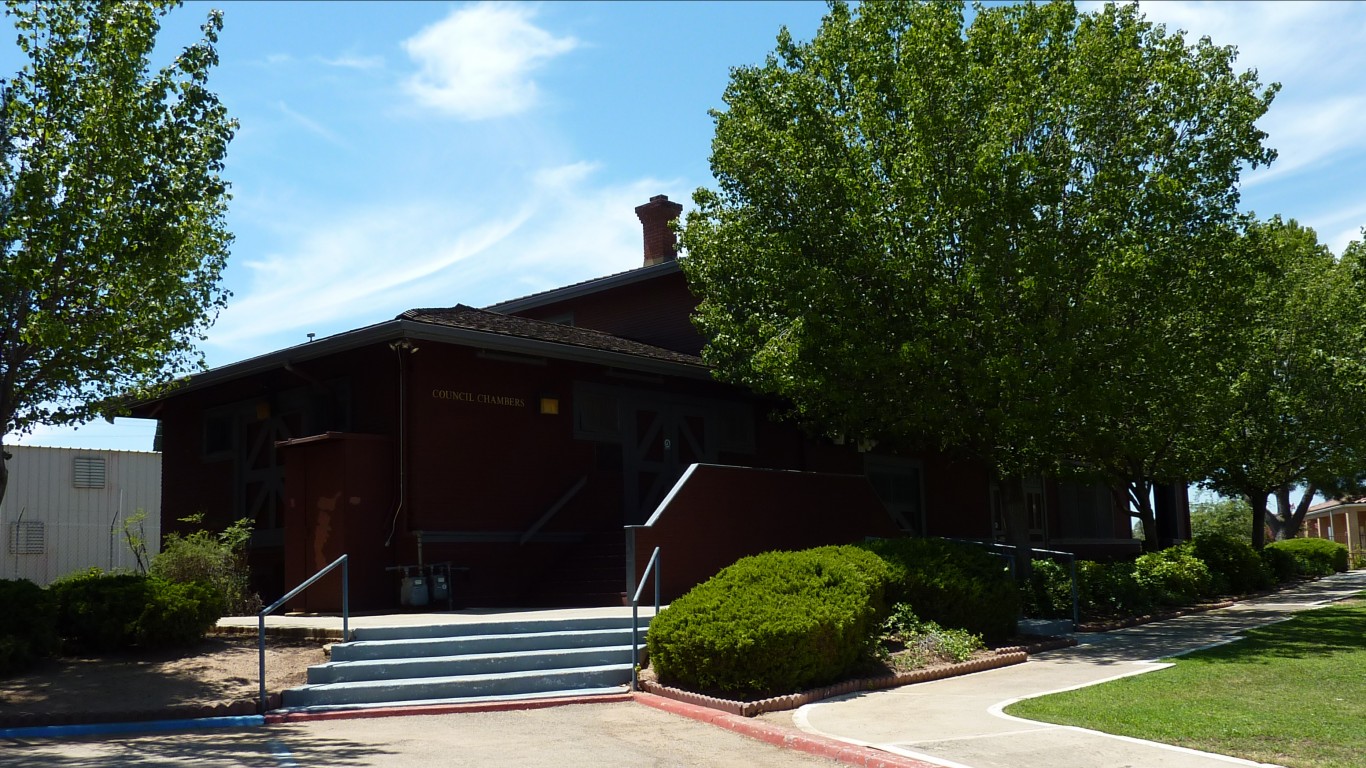
California: Orange Cove
> Median household income: $25,660 (state: $71,228)
> Poverty rate: 47.8% (state: 14.3%)
> Median home value: $129,000 (state: $475,900)
> Population: 9,564
Orange Cove is a small city of approximately 9,600 residents in Fresno County. The typical Orange Cove household earns just $25,660 a year, nearly one-third of the statewide median household income of $71,228 and less than half the national figure of $60,293.
One of the main determinants of income is educational attainment. In Orange Cove, just 44.6% of adults have a high school diploma — the fourth smallest share of any small community in California and among the smallest of any city nationwide. By comparison, the statewide high school attainment rate among adults is 82.9%.
[in-text-ad-2]
Colorado: Lamar
> Median household income: $37,554 (state: $68,811)
> Poverty rate: 22.4% (state: 10.9%)
> Median home value: $87,500 (state: $313,600)
> Population: 7,606
Colorado is a relatively high-income state, with most households earning at least $68,811 annually, about $8,000 more than the national median income. Not all parts of the state have higher incomes, however. In Lamar, a small municipality near the state’s eastern border, most households earn less than $38,000 per year.
The area’s lack of economic opportunity may be pushing people out of Lamar. In the last five years, the city’s population has contracted by 3.4%. Meanwhile, Colorado’s population grew by 8.0% over the same period.
Connecticut: Groton
> Median household income: $53,750 (state: $76,106)
> Poverty rate: 13.7% (state: 10.0%)
> Median home value: $207,900 (state: $272,700)
> Population: 9,109
With a median household income of $76,106 — about $16,000 more than the national median — Connecticut is one of the wealthiest states in the country. Not all parts of the state have higher income than the national median, however. In Groton, located in south-central Connecticut along the Long Island Sound, most households earn less than $54,000 a year.
Still, despite the relatively lower median income, serious financial hardship is not especially common in Groton. Just 13.7% of area residents live below the poverty line, below the 14.1% U.S. poverty rate.
[in-text-ad]
Delaware: New Castle
> Median household income: $63,573 (state: $65,627)
> Poverty rate: 6.5% (state: 11.9%)
> Median home value: $195,400 (state: $244,700)
> Population: 5,359
Delaware is the only state in the country where the poorest place with a population between 1,000 and 25,000 has a higher median income than the U.S. median as a whole. The median annual household income in New Castle of $63,573 is the lowest median household income of any similarly sized place in the state. It is only slightly below the statewide median of $65,627 and above the national median of $60,293.
Despite slightly lower than average incomes, relatively few residents are in a dire financial situation. Just 6.5% of New Castle residents live below the poverty line, compared to 11.9% of Delaware residents and 14.1% of Americans nationwide.

Florida: Avon Park
> Median household income: $30,675 (state: $53,267)
> Poverty rate: 33.0% (state: 14.8%)
> Median home value: $68,400 (state: $196,800)
> Population: 10,386
Avon Park is the poorest place in Florida and one of the poorest places in the United States. The city, centrally located in the state and home to about 10,000 people, has a median household income of just $30,675, well below the statewide median of $53,267 and about half the national median income. Additionally, nearly one-third of area residents live below the poverty line — more than double both the state and national poverty rates.
Property values in Avon Park reflect the area’s low incomes. The typical area home is worth just $68,400 — less than half the value of the typical home in the state of $196,800.
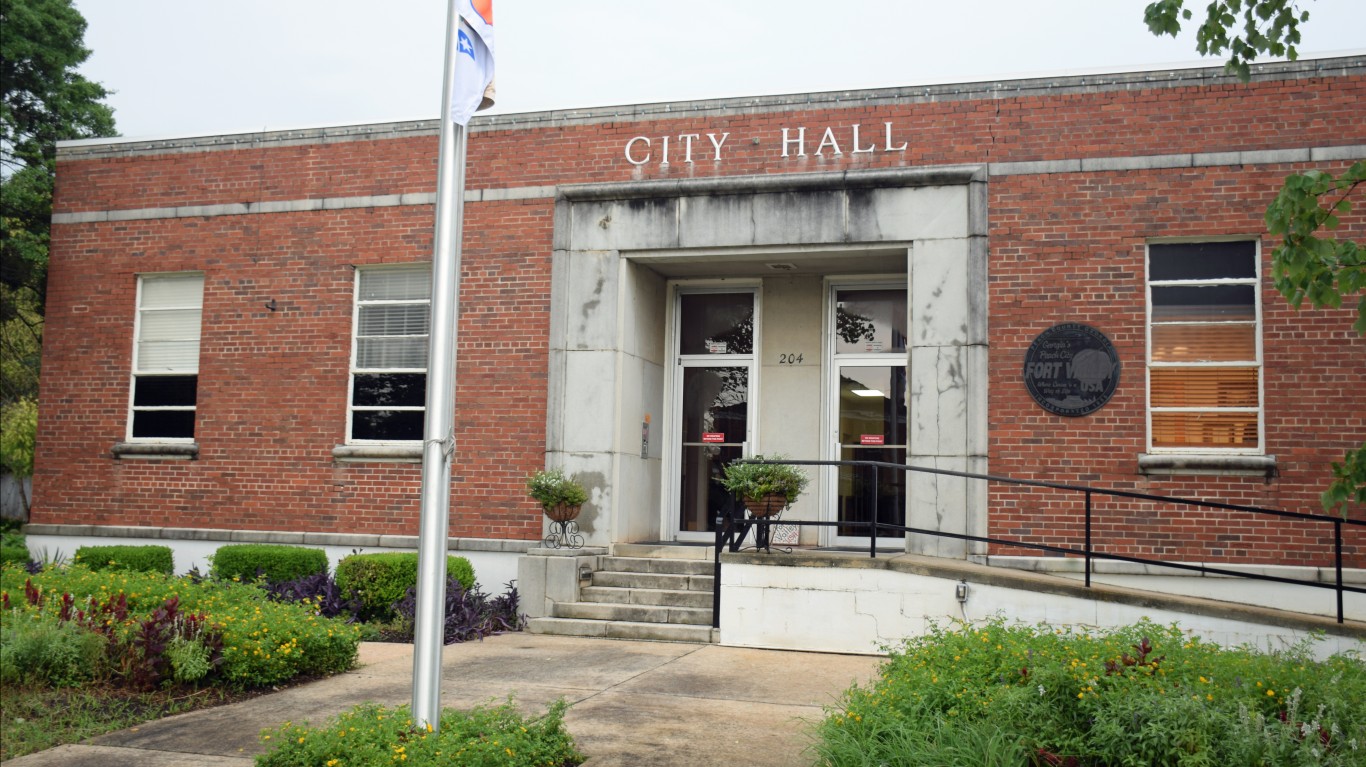
Georgia: Fort Valley
> Median household income: $23,542 (state: $55,679)
> Poverty rate: 38.3% (state: 16.0%)
> Median home value: $78,700 (state: $166,800)
> Population: 8,740
Georgia’s poorest small city — Fort Valley — is also one of the poorest places in the United States. Most households in Fort Valley earn less than $24,000 a year, and 38.3% of the city’s 8,740 residents live below the poverty line. Meanwhile, most households in Georgia earn over $55,000 a year and just 16.0% of the state population lives below the poverty line.
The area’s lack of economic opportunity may be pushing people out of Fort Valley. In the last five years, the city’s population has contracted by 9.2%. Meanwhile, Georgia’s population grew by 5.0% over the same period.
Black Americans are more than twice as likely as white Americans to live in poverty in the United States, and more than 75% of the city’s residents are black, one of the highest shares of any place in the state.
[in-text-ad-2]

Hawaii: Waianae
> Median household income: $59,213 (state: $78,084)
> Poverty rate: 27.8% (state: 9.9%)
> Median home value: $360,800 (state: $587,700)
> Population: 14,054
Hawaii has one of the highest household incomes among states in the country. Most households in the state earn over $78,000 a year — about $28,000 more than the median household income nationwide. Even in Waianae, the lowest-income place in the state, the typical household earns $59,213, in line with the national median of $60,293.
Even though Waianae’s median household income is not especially low in the context of the U.S. as a whole, a disproportionately large share of area residents are in a dire financial situation. A staggering 27.8% of the Waianae population lives below the poverty line, nearly triple the 9.9% state poverty rate and nearly double the 14.1% national poverty rate.
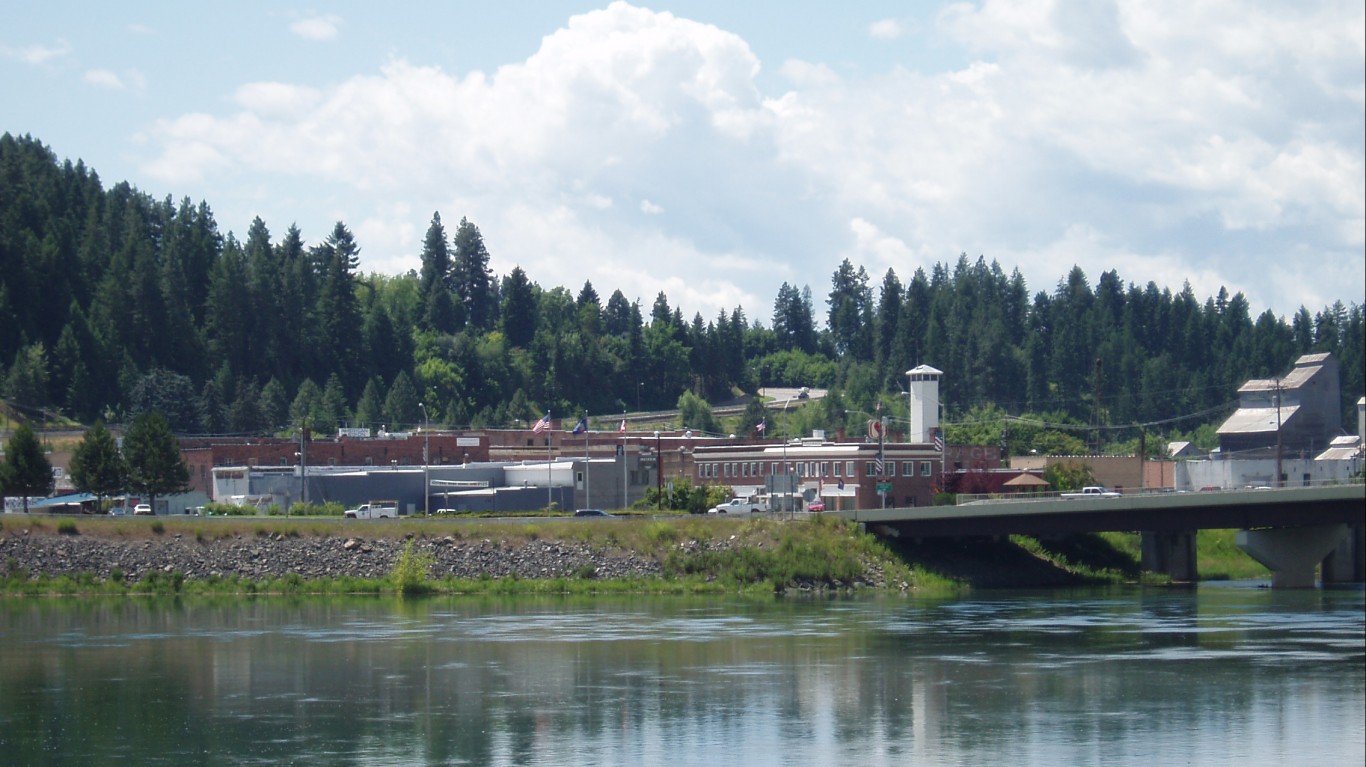
Idaho: Bonners Ferry
> Median household income: $31,619 (state: $53,089)
> Poverty rate: 22.4% (state: 13.8%)
> Median home value: $155,800 (state: $192,300)
> Population: 2,544
Bonners Ferry is a small city of about 2,500 people in northern Idaho. The poorest place in the state, Bonners Ferry has a median household income of just $31,619 — well below the median income across Idaho of $53,089. A lack of high-paying jobs may be pushing people out of Bonners Ferry. Over the last five years, the number of people living there fell by 21.1%. Meanwhile, Idaho’s population expanded by 6.6% over the same period, driven in part by rapid growth in wealthier cities like Boise and Meridian.
[in-text-ad]

Illinois: Roodhouse
> Median household income: $32,335 (state: $63,575)
> Poverty rate: 22.3% (state: 13.1%)
> Median home value: $47,600 (state: $187,200)
> Population: 1,792
Most households in the small western Illinois city of Roodhouse earn less than $33,000 a year. Meanwhile, most households across the state as a whole earn over $63,000 a year. With a low median household income, Roodhouse also has a far greater than average concentration of poverty. The city’s 22.3% poverty rate is well above both the 13.1% state poverty rate and the 14.1% U.S. rate.
Property values are often reflective of incomes in a given community. In Roodhouse, the typical home is worth just $47,600, a fraction of the median home value in Illinois of $187,200.

Indiana: Connersville
> Median household income: $33,415 (state: $54,325)
> Poverty rate: 24.9% (state: 14.1%)
> Median home value: $71,000 (state: $135,400)
> Population: 13,069
Connersville, a small eastern Indiana city, is the poorest small city in the state. About one in every four residents live below the poverty line, well above the 14.1% poverty rate statewide and nationwide. Additionally, the typical area household earns just $33,415 a year — more than $20,000 less than the typical Indiana household.
Connersville, once colloquially referred to as “Little Detroit,” is a Rust Belt city that has undergone years of economic decline along with the decline of its once strong manufacturing industry. The reduced economic opportunity in Connersville has reportedly led to a sharp rise in suicides and substance abuse.
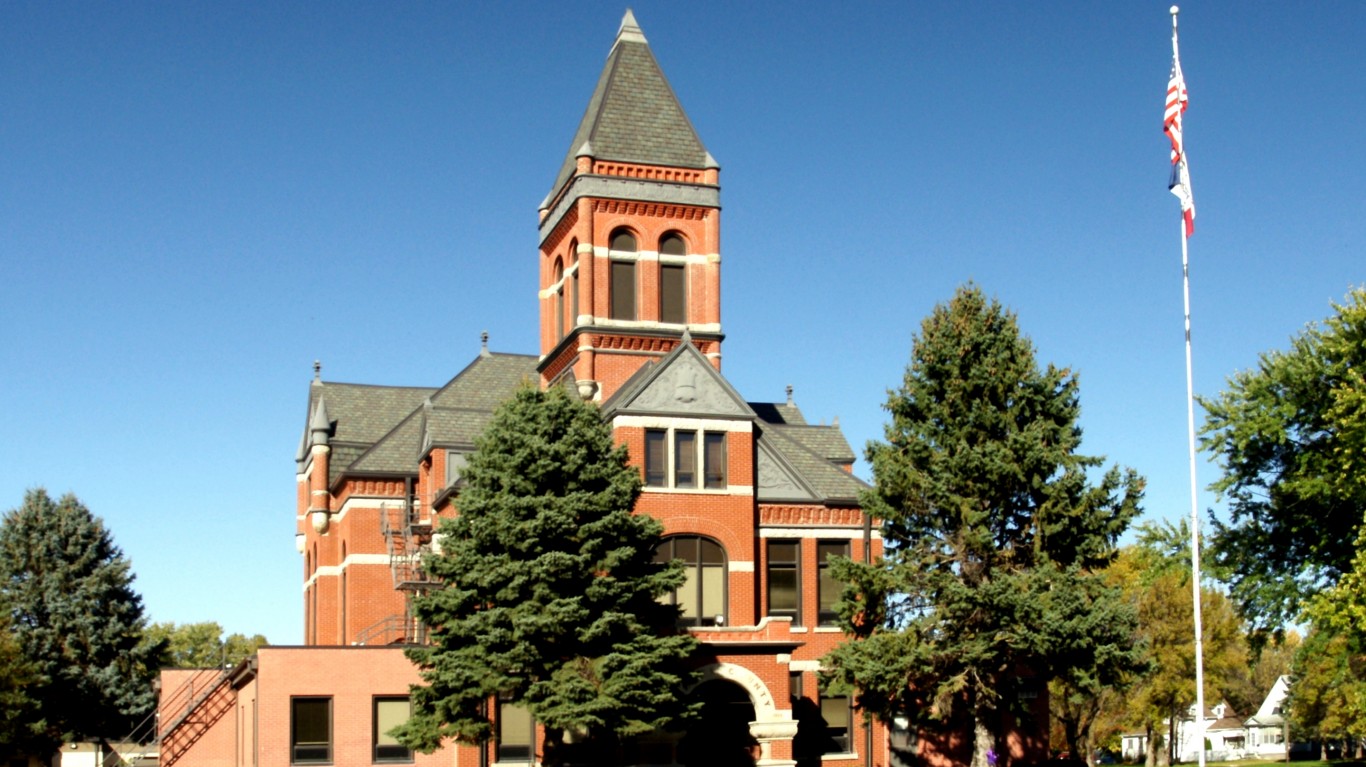
Iowa: Onawa
> Median household income: $31,469 (state: $58,580)
> Poverty rate: 28.8% (state: 11.7%)
> Median home value: $87,400 (state: $142,300)
> Population: 2,830
Onawa is a small city of less than 3,000 in western Iowa. With a median household income of less than $32,000 per year and a poverty rate of nearly 29%, Onawa is the poorest place in the state.
As is typical of the communities on this list, Onawa is losing residents rapidly. Over the last half decade, Onawa’s population contracted by 5.0%, even as Iowa as a whole reported a 2.3% population growth.
[in-text-ad-2]
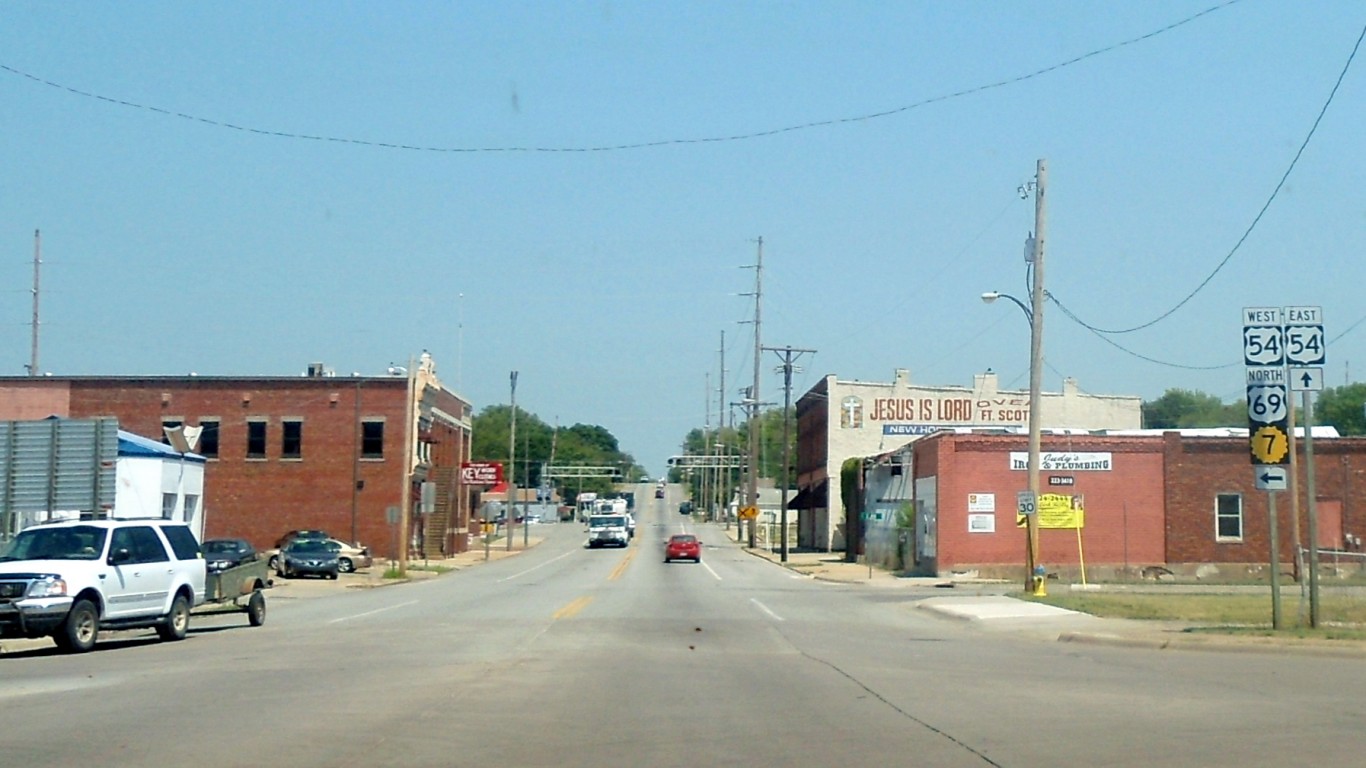
Kansas: Fort Scott
> Median household income: $32,576 (state: $57,422)
> Poverty rate: 18.8% (state: 12.4%)
> Median home value: $62,300 (state: $145,400)
> Population: 7,800
Fort Scott, Kansas, has a median household income of just $32,576 — the lowest of any community in the state of similar size. Incomes tend to increase with educational attainment — both on an individual level and across populations. In Fort Scott, just 18.4% of adults have a bachelor’s degree or higher, compared to 32.9% of adults across the state as a whole.
The area’s low incomes are reflected by low real estate values. The typical home in Fort Scott is worth just $62,300, less than half the $145,400 median home value statewide.

Kentucky: Paducah
> Median household income: $35,419 (state: $48,392)
> Poverty rate: 22.3% (state: 17.9%)
> Median home value: $117,900 (state: $135,300)
> Population: 24,879
Paducah is a small city in western Kentucky located along the southern bank of the Ohio River. The typical Paducah household earns just $35,419 a year, well below the median income statewide of $48,392. Poverty is also more concentrated in Paducah than it is across the state as a whole. More than 22% of the local population lives below the poverty line, compared to about 18% of all Kentucky residents.
[in-text-ad]
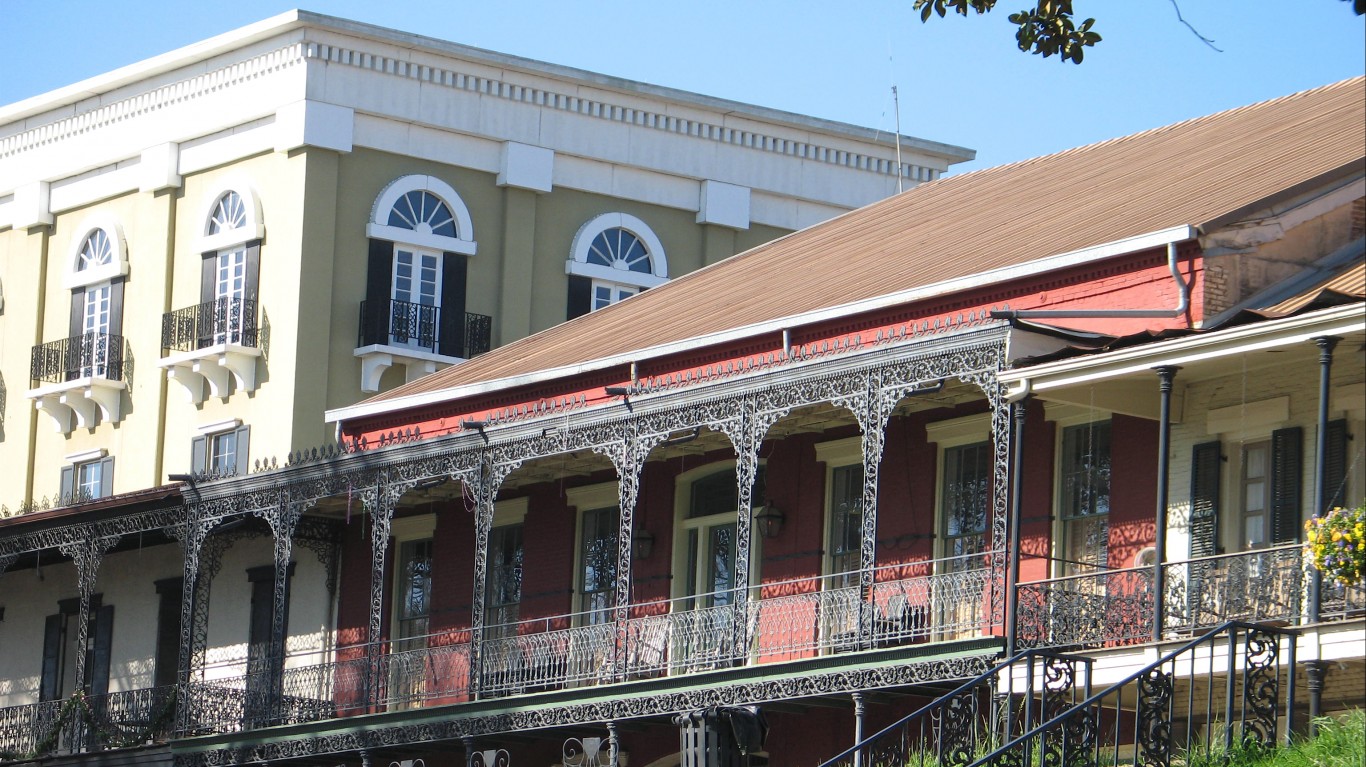
Louisiana: Natchitoches
> Median household income: $21,854 (state: $47,942)
> Poverty rate: 46.8% (state: 19.4%)
> Median home value: $156,000 (state: $157,800)
> Population: 18,080
Natchitoches is the poorest place in one of the poorest states. Most households in Louisiana earn less than $48,000 a year, while most households nationwide earn over $60,000. In Natchitoches, most households earn less than $22,000 a year. Serious financial hardship is widespread in the city as nearly half of the area’s 18,000 residents live below the poverty line.
Despite the area’s low incomes, property values in Natchitoches closely match what is typical across the state as a whole. The median home value in the area is $156,000 — only slightly less than the typical home value across Louisiana of $157,800.
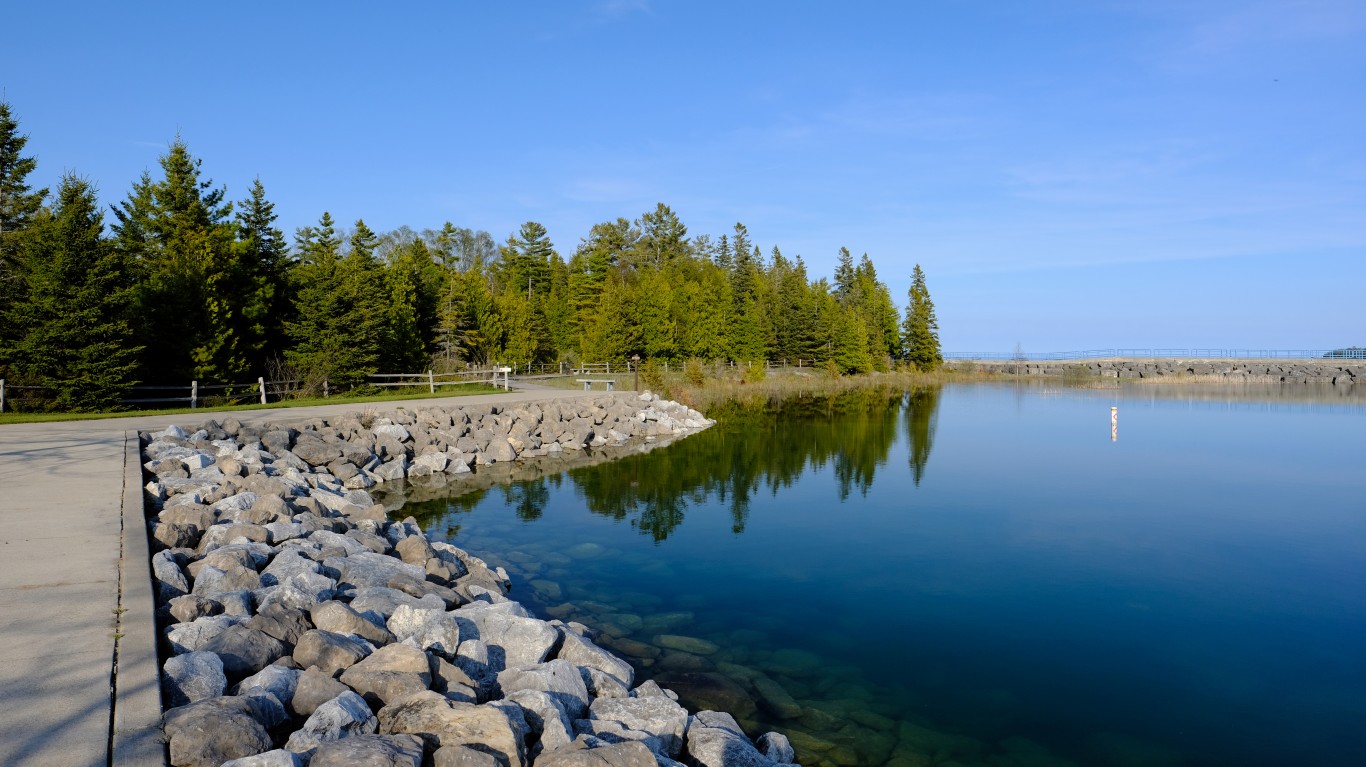
Maine: Presque Isle
> Median household income: $37,401 (state: $55,425)
> Poverty rate: 22.0% (state: 12.5%)
> Median home value: $107,000 (state: $184,500)
> Population: 9,162
Presque Isle is a small city of approximately 9,200 residents located in Aroostook County in northern Maine. The typical Presque Isle household earns just $37,401 a year, the least of any similarly-sized place in Maine and far less than the state median household income of $55,425.
Individuals with higher educational attainment are more likely to have advanced, high-paying jobs and have higher incomes overall. In Presque Isle, just 23.5% of adults have a bachelor’s degree, the third smallest share of any smaller community in Maine and far less than the 30.9% state college attainment rate.
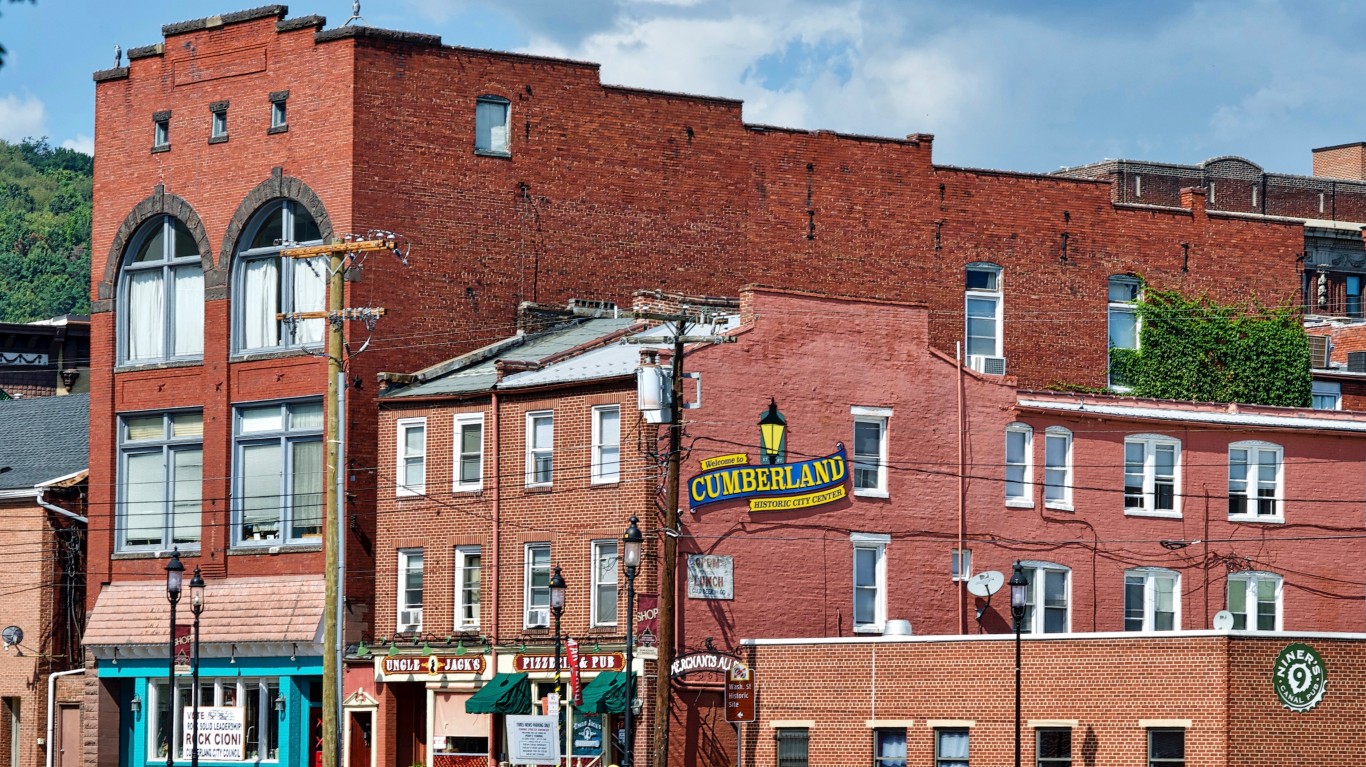
Maryland: Cumberland
> Median household income: $34,750 (state: $81,868)
> Poverty rate: 22.6% (state: 9.4%)
> Median home value: $93,000 (state: $305,500)
> Population: 19,845
Cumberland, Maryland, is the poorest place in the wealthiest state. Most households in Cumberland earn just $34,750 a year — less than half the median income of $81,868 across Maryland, the highest of any state.
Cumberland was once a prosperous city, serving as a major transportation and industrial hub and as the second largest manufacturing center in the state. Economic conditions have declined in recent decades, however, likely contributing to a mass exodus. The city’s population peaked at about 39,500 in 1940. Now, after contracting by 4.2% in the last five years alone, Cumberland’s population stands at less than 20,000.
[in-text-ad-2]
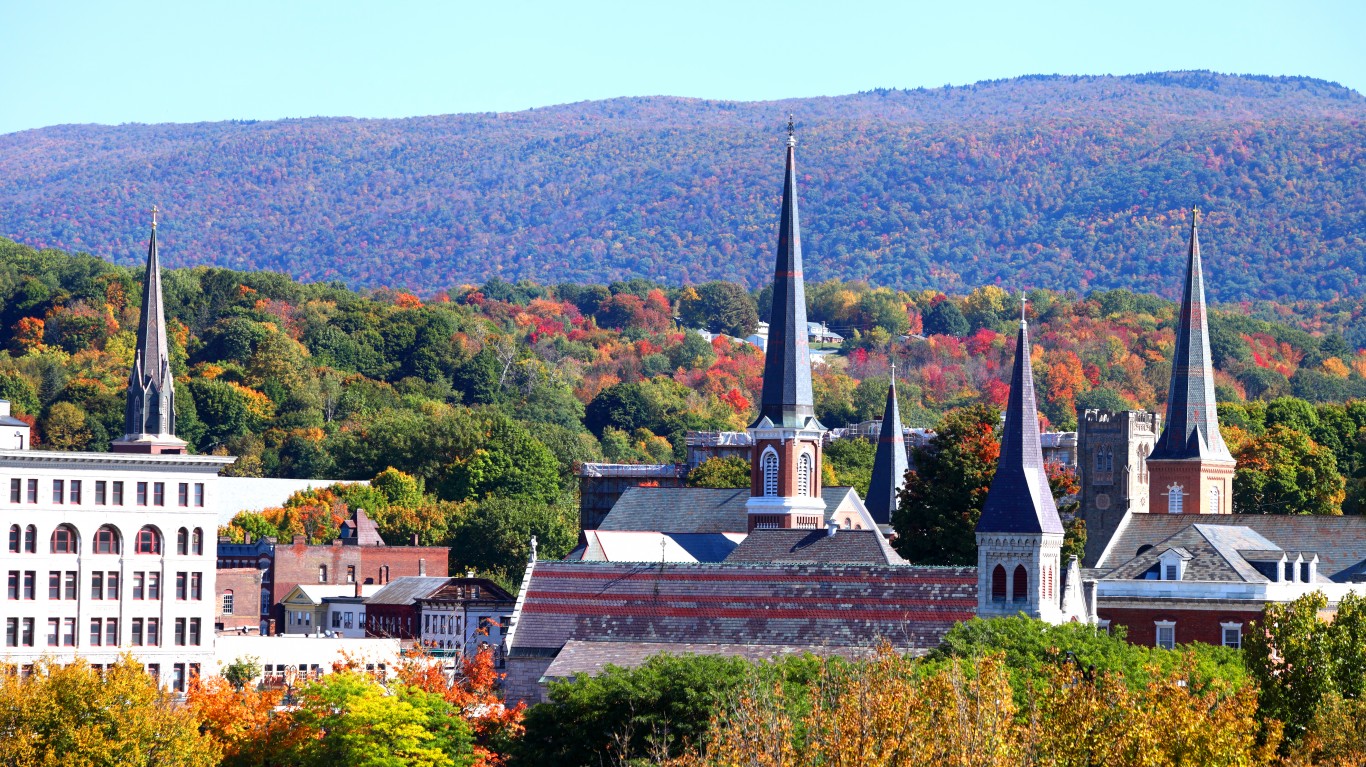
Massachusetts: North Adams
> Median household income: $39,411 (state: $77,378)
> Poverty rate: 17.5% (state: 10.8%)
> Median home value: $144,300 (state: $366,800)
> Population: 13,089
North Adams, Massachusetts, is a former industrial hub that has undergone decades of economic decline. Massachusetts is a relatively high-income state, and North Adams is the only community with a population between 1,000 and 25,000 statewide where most households earn less than $40,000 a year.
Like many post-industrial American cities, North Adams is reinventing itself as a tourist destination, taking advantage of the scenic beauty of the mountainous and rural Berkshire region where it is located.

Michigan: Hamtramck
> Median household income: $25,478 (state: $54,938)
> Poverty rate: 49.1% (state: 15.0%)
> Median home value: $64,500 (state: $146,200)
> Population: 21,941
Hamtramck, Michigan, is a small city of about 22,000 surrounded by the city of Detroit. Many of the economic problems Hamtramck faces mirror those of its much larger neighbor. A victim of the decline of American manufacturing, Hamtramck has a staggering 49.1% poverty rate, more than triple the state poverty rate of 15.0%. Additionally, Hamtramck is the only place of any size in the state where the majority of households earn less than $26,000 a year.
Property values often reflect incomes in a given community. In Hamtramck, the typical home is worth just $64,500, a fraction of the median home value in Michigan of $146,200.
[in-text-ad]
Minnesota: Little Falls
> Median household income: $38,862 (state: $68,411)
> Poverty rate: 18.0% (state: 10.1%)
> Median home value: $128,400 (state: $211,800)
> Population: 8,664
Little Falls is a small community located along the banks of the Mississippi River in central Minnesota. The poorest place in the state, Little Falls has a median household income of just $38,862 — about $30,000 below the statewide median. Incomes tend to rise with educational attainment, and in Little Falls, only about one in every five adults have a bachelor’s degree. Meanwhile, across Minnesota, more than one in three adults have a four-year college degree.
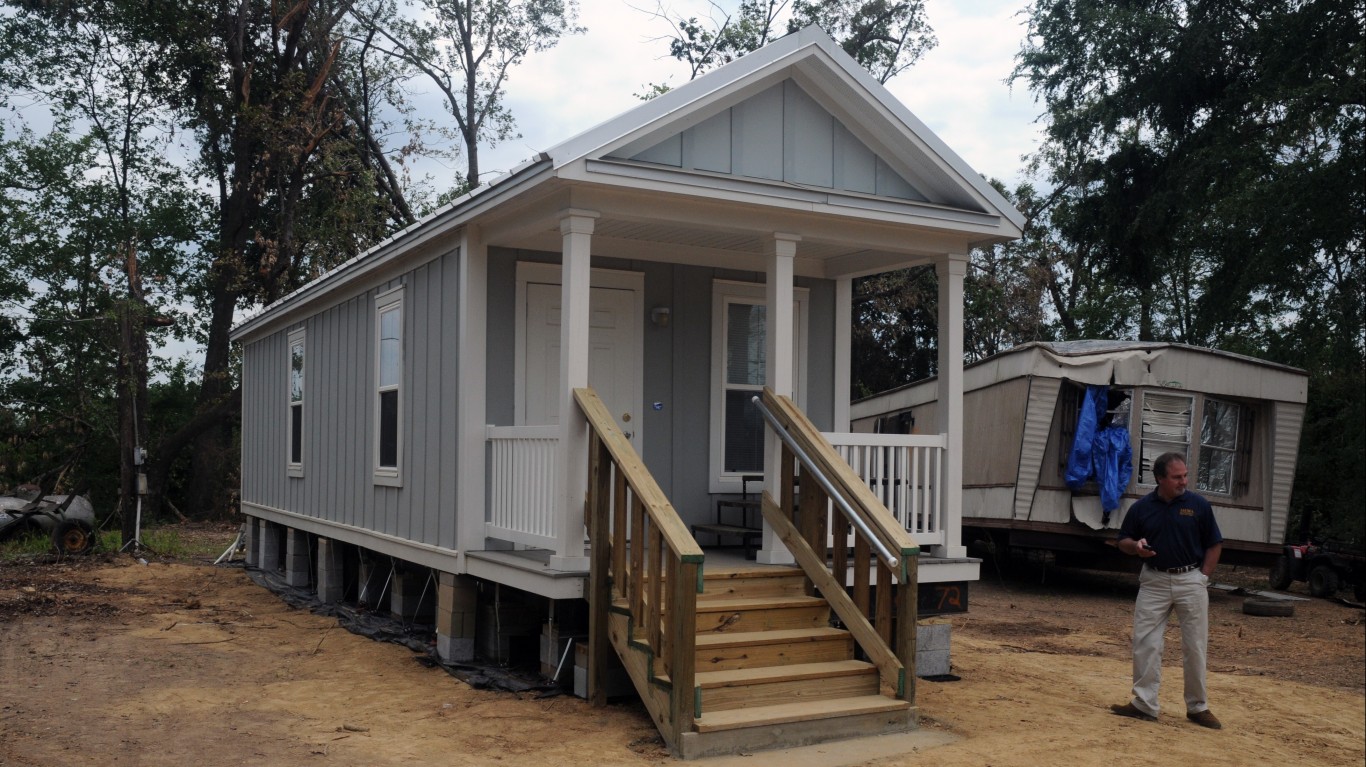
Mississippi: Yazoo City
> Median household income: $23,970 (state: $43,567)
> Poverty rate: 42.6% (state: 20.8%)
> Median home value: $68,300 (state: $114,500)
> Population: 11,076
Mississippi is the poorest state in the country, with a median household income of $43,567 — about $17,000 below the national median. In Yazoo City, a small community in the Delta region, incomes are lower than they are anywhere else in the state. Most households in Yazoo City earn less than $24,000 a year. The city also has a staggering 42.6% poverty rate, more than double Mississippi’s poverty rate of 20.8%.
With low incomes, a larger than typical share of the population depends on government benefits to afford basic necessities. About 40% of area households receive SNAP benefits, more than double the 16.5% share of households across Mississippi. Black Americans are more than twice as likely as white Americans to live in poverty in the United States, and more than 80% of the city’s residents are black, one of the highest shares of any place in the state.
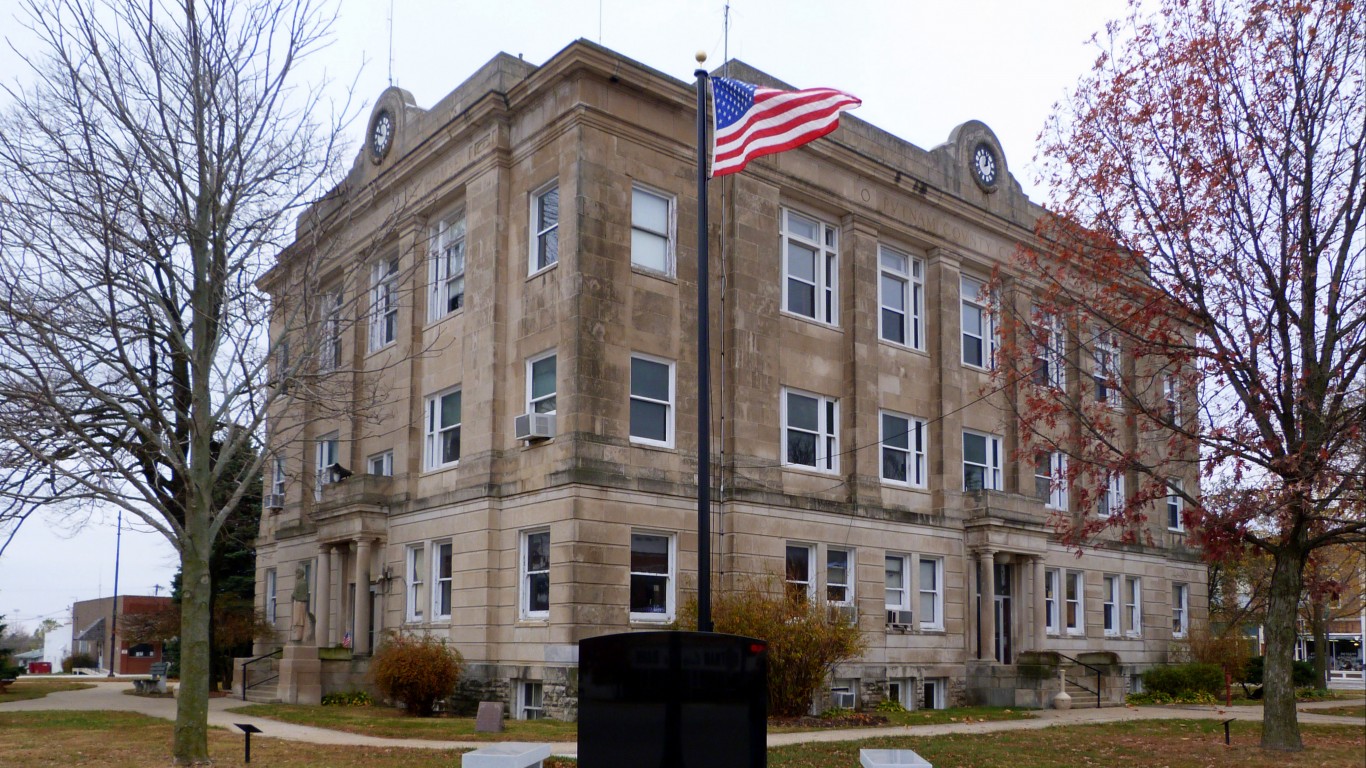
Missouri: Unionville
> Median household income: $29,440 (state: $53,560)
> Poverty rate: 25.1% (state: 14.2%)
> Median home value: $63,600 (state: $151,600)
> Population: 1,998
Unionville is the only community in Missouri where the majority of households earn less than $30,000 annually. Incomes tend to go up with educational attainment, and in Unionville, only 11.2% of adults have a bachelor’s degree or higher, well below the comparable statewide bachelor’s degree attainment rate of 28.6%.
The area’s low incomes are reflected by low real estate values. The typical home in Unionville is worth just $63,600, less than half the median home value of $151,600 statewide.
[in-text-ad-2]
Montana: Havre
> Median household income: $46,419 (state: $52,559)
> Poverty rate: 17.7% (state: 13.7%)
> Median home value: $143,900 (state: $219,600)
> Population: 9,762
Of all places in Montana that are home to between 1,000 and 25,000 people, Havre has the lowest median household income. Despite its distinction as the poorest small city in the state, Havre does not have particularly bad economic conditions relative to the state as a whole. The typical Havre household earns $46,419 a year, only about $6,000 less than the median household income across Montana.
While most of the places on this list are experiencing population decline, Havre is growing. Over the last five years, the number of people living in the area climbed by 2.2%. However, this growth still trails the state’s 4.3% population growth rate.

Nebraska: Superior
> Median household income: $36,422 (state: $59,116)
> Poverty rate: 12.7% (state: 11.6%)
> Median home value: $61,100 (state: $147,800)
> Population: 1,929
Superior is a small city of approximately 1,900 residents in southeastern Nebraska. The typical Superior household earns just $36,422 a year, the least of any place in Nebraska and far less than the state median household income of $59,116. The typical home is worth just $61,000, the lowest median home value of any place in Nebraska and nearly the lowest nationwide.
One of the main determinants of income is educational attainment. In Superior, just 21.4% of adults have a bachelor’s degree, far less than the 31.3% state college attainment rate and than the 31.5% national figure.
[in-text-ad]

Nevada: Laughlin
> Median household income: $33,851 (state: $57,598)
> Poverty rate: 15.1% (state: 13.7%)
> Median home value: $147,600 (state: $242,400)
> Population: 7,502
Laughlin is a Census designated place in southern Nevada. It is the only community in the state where most households earn less than $34,000 a year. Incomes tend to rise with educational attainment, and in Laughlin, only 13.0% of adults have a bachelor’s degree or higher, well below the 24.2% share of adults across Nevada.
As is typically the case among the places on this list, Laughlin is losing residents faster than it is drawing them in. In the last five years, the number of people living there fell by 2.5%, even as Nevada’s population expanded by 7.1%.
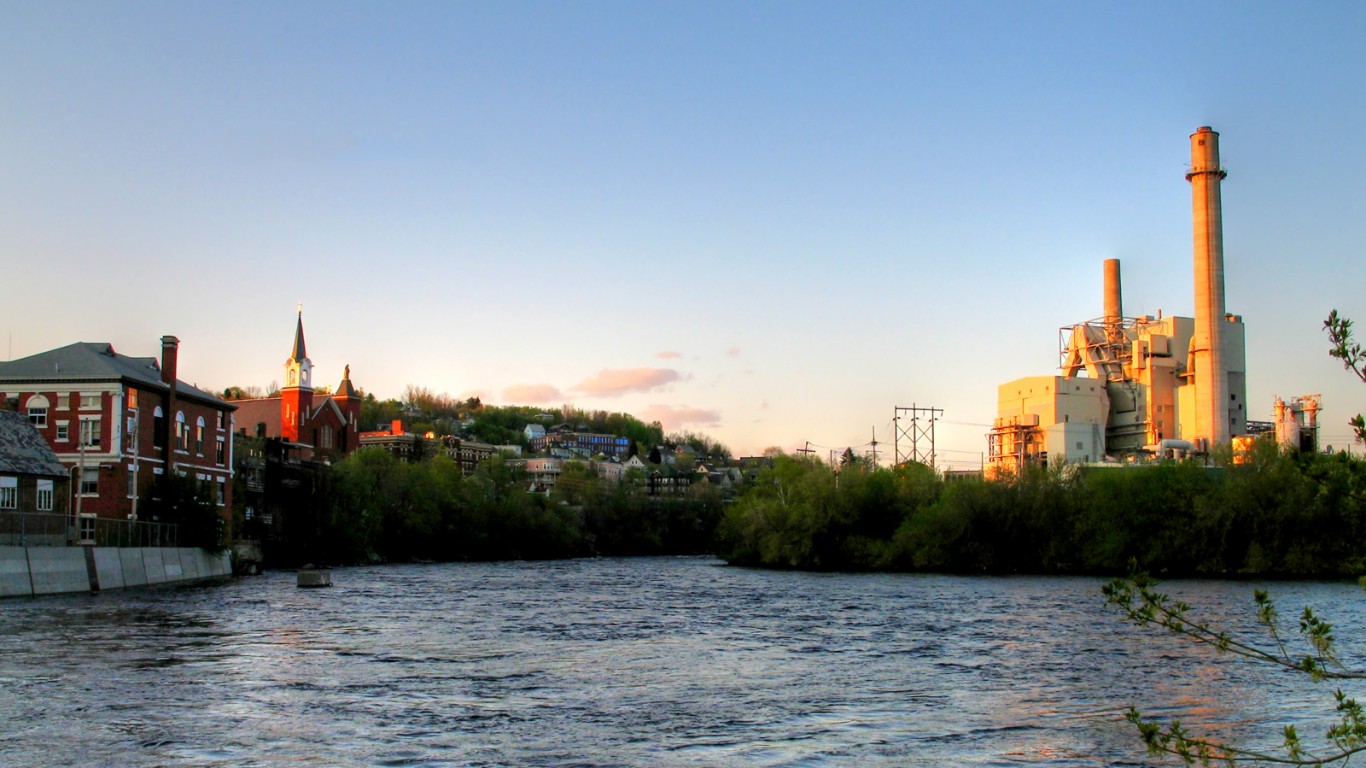
New Hampshire: Berlin
> Median household income: $38,315 (state: $74,057)
> Poverty rate: 19.8% (state: 7.9%)
> Median home value: $88,300 (state: $252,800)
> Population: 10,382
Berlin is a small city of about 10,000 in northern New Hampshire. The poorest community in the state, Berlin has a median household income of just $38,315, only slightly more than half the statewide median household income of $74,057. Berlin’s real estate values reflect the area’s low incomes. Most houses in Berlin are worth less than $90,000, while most homes across New Hampshire are worth over a quarter of a million dollars.
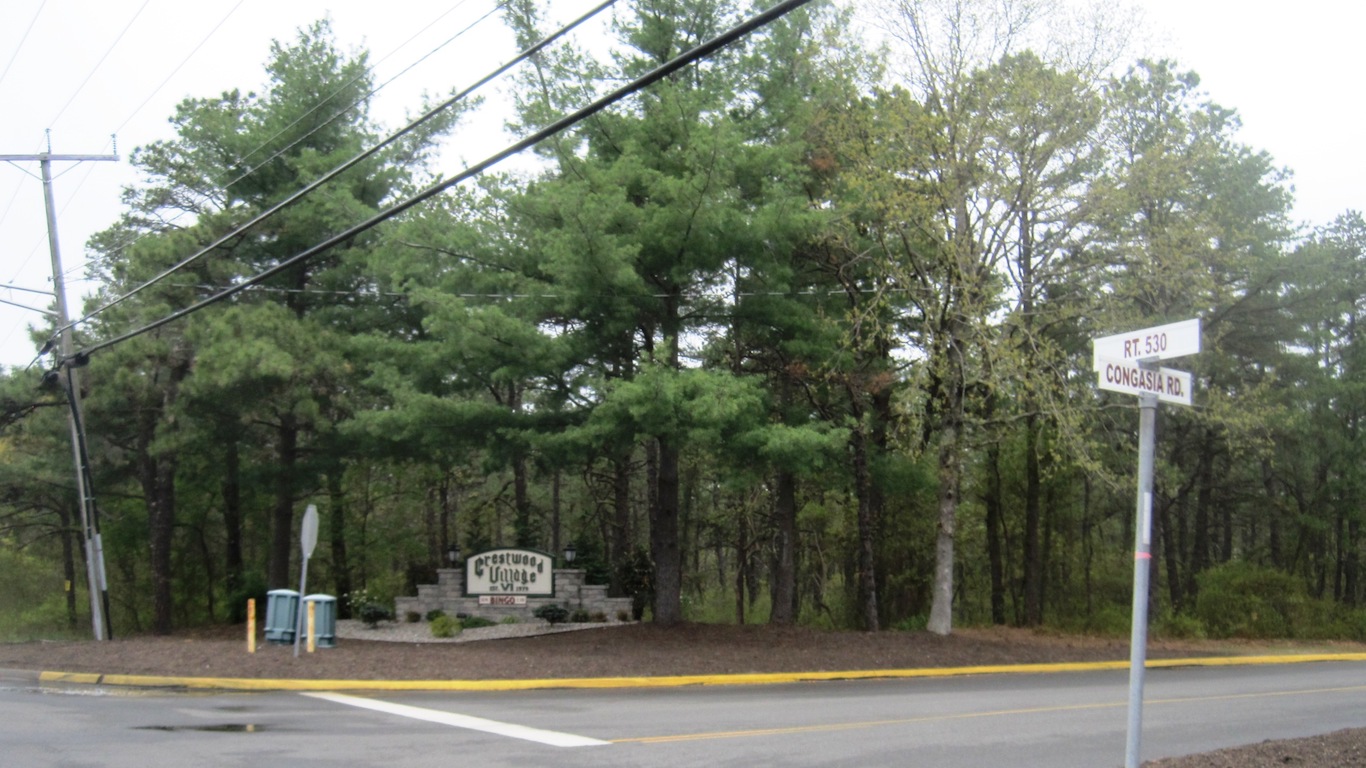
New Jersey: Crestwood Village
> Median household income: $28,708 (state: $79,363)
> Poverty rate: 10.4% (state: 10.4%)
> Median home value: $72,700 (state: $327,900)
> Population: 8,164
Though New Jersey is home to lower-income places, including Atlantic City and Camden, Crestwood Village, a Census designated place in central New Jersey, is the state’s poorest community with a population of less than 25,000. The typical household in Crestwood Village earns only $28,708 a year, far less than half the median income across the state of $79,363.
Despite the low incomes, area residents are not more likely to live below the poverty line than the typical New Jersey resident. Crestwood Village has a 10.4% poverty rate, in line with New Jersey’s poverty rate.
[in-text-ad-2]

New Mexico: Belen
> Median household income: $33,553 (state: $48,059)
> Poverty rate: 24.4% (state: 20.0%)
> Median home value: $104,300 (state: $166,800)
> Population: 7,106
Belen is a small city in central New Mexico, about 30 miles south of Albuquerque. Most households in Belen earn less than $34,000 a year, and nearly a quarter of local residents live below the poverty line. Meanwhile, most households across New Mexico earn over $48,000 a year, and one in five state residents live below the poverty line.
Due to low incomes in the area, Belen residents are more likely to depend on government benefits to be able to afford food. Nearly 30% of area households receive SNAP benefits, compared to the 16.9% statewide SNAP recipiency rate.
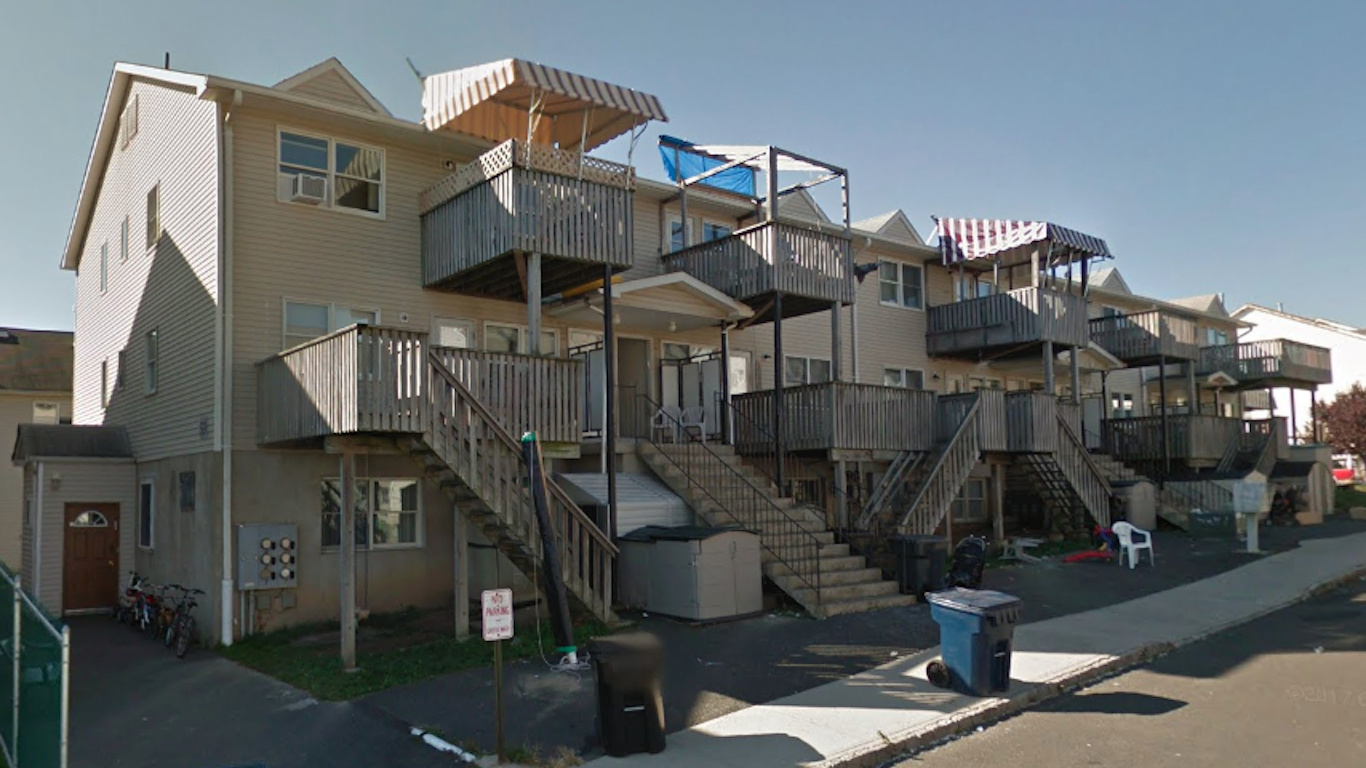
New York: New Square
> Median household income: $23,578 (state: $65,323)
> Poverty rate: 63.3% (state: 14.6%)
> Median home value: $376,400 (state: $302,200)
> Population: 8,133
New Square is a Hasidic Jewish village located in Rockland County some 25 miles north of midtown Manhattan. According to data from the Census Bureau, the typical New Square household earns just $23,578 a year, the least of any similarly-sized place in New York state and less than half the state median household income of $65,323.
While incomes in New Square are the lowest in the state, fewer families may struggle financially than in areas with similarly low income. Despite the low incomes, the typical home in New Square is worth $376,400 — far more than the median home value statewide of $302,200.
[in-text-ad]
North Carolina: Laurinburg
> Median household income: $29,388 (state: $52,413)
> Poverty rate: 34.0% (state: 15.4%)
> Median home value: $102,400 (state: $165,900)
> Population: 15,253
Laurinburg is the poorest place in North Carolina. Most households in the area earn less than $30,000 a year, and more than one in every three residents live below the poverty line.
As is often the case among the places on this list, Laurinburg is losing residents faster than it is drawing them in. Over the last five years, the Laurinburg population contracted by 4.1%, even as North Carolina’s population grew by 5.2%. The statewide population growth was likely driven in part by rapid growth in higher-income places like Huntersville and Wake Forest.
North Dakota: Valley City
> Median household income: $49,194 (state: $63,473)
> Poverty rate: 11.4% (state: 10.9%)
> Median home value: $110,000 (state: $185,000)
> Population: 6,487
Valley City is a small city of approximately 6,500 located in Barnes County, North Dakota. The typical household in Valley City earns $49,194 a year, less than both the state median household income of $63,473 and the national figure of $60,293.
While incomes in Valley City are the lowest in the state, the share of residents living below the poverty line is lower than it is nationwide. Some 11.4% of Valley City residents live below the poverty line, slightly more than the 10.9% state poverty rate yet far below the 14.1% national figure.
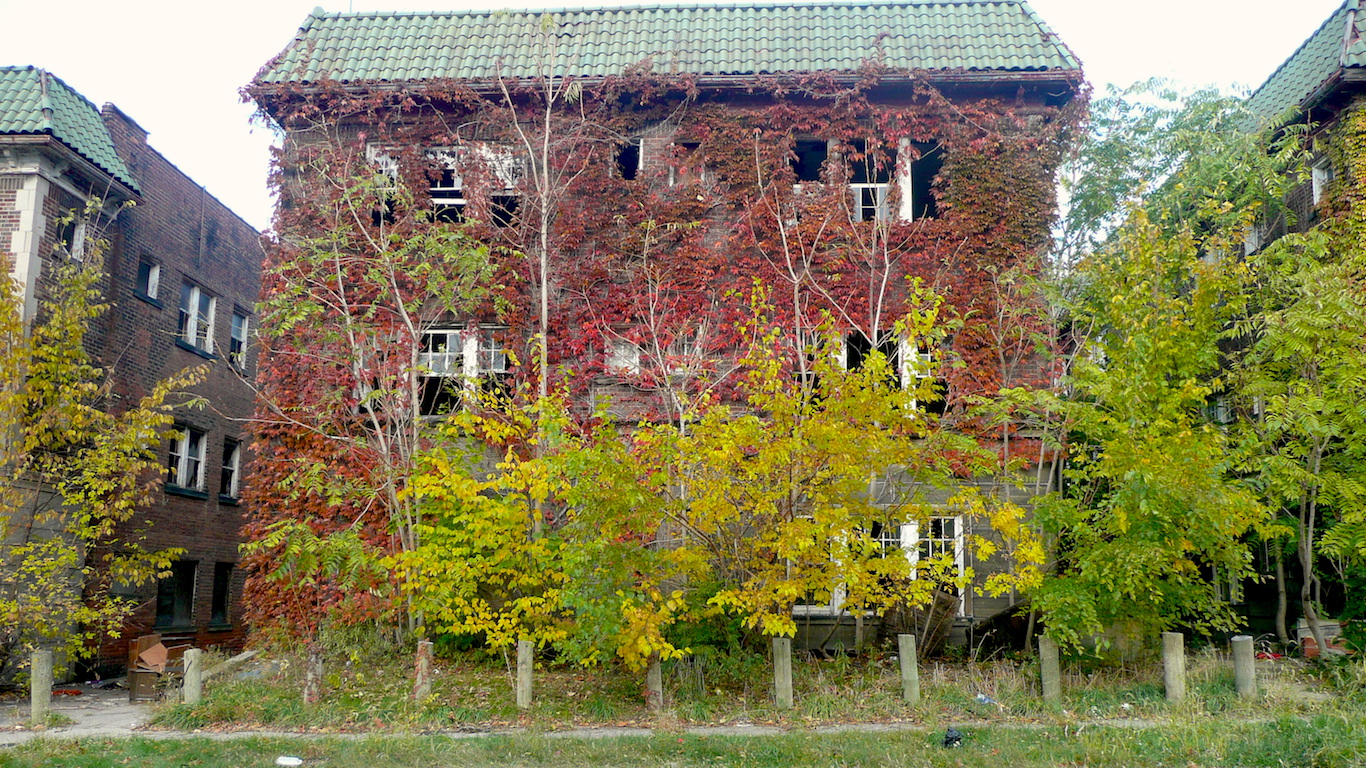
Ohio: East Cleveland
> Median household income: $21,439 (state: $54,533)
> Poverty rate: 38.9% (state: 14.5%)
> Median home value: $57,800 (state: $140,000)
> Population: 17,321
East Cleveland is the poorest place in Ohio and one of the poorest places in the United States. Decades of deteriorating economic conditions and difficult circumstances in the majority-black community, including racist housing policies and deindustrialization, have contributed to widespread poverty and lack of high-paying employment opportunities.
Most households in East Cleveland earn less than $22,000 a year, and more than one-quarter of households earn less than $10,000. Nearly 40% of East Cleveland residents live below the poverty line, more than double the 14.5% state poverty rate.
[in-text-ad-2]
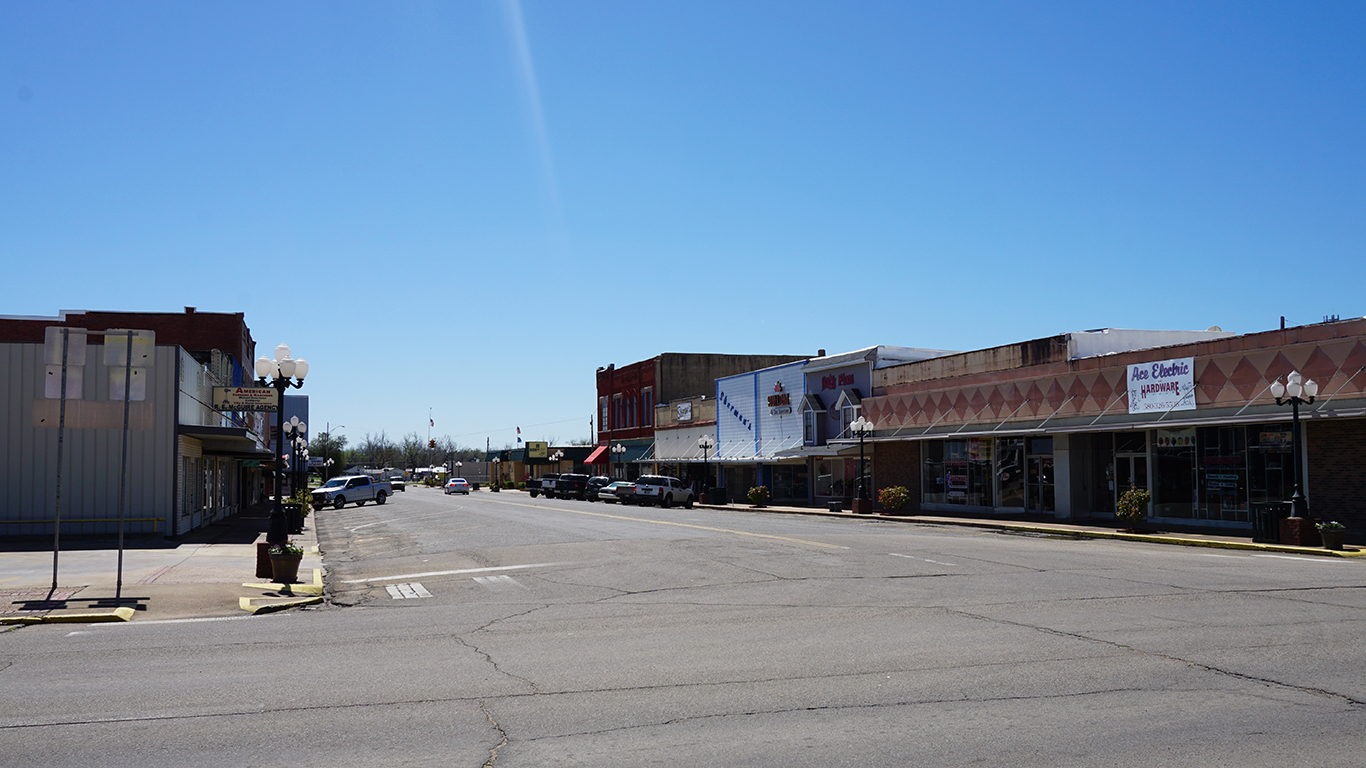
Oklahoma: Hugo
> Median household income: $24,548 (state: $51,424)
> Poverty rate: 41.5% (state: 16.0%)
> Median home value: $64,400 (state: $130,900)
> Population: 5,184
Hugo is a city of some 5,200 residents located in Choctaw County, Oklahoma. The typical household in Hugo earns just $24,548 a year, less than half the $51,424 state median household income and far less than the $60,293 national figure.
One of the largest determinants of income is educational attainment. In Hugo, just 9.3% of adults have a bachelor’s degree, less than half the 25.2% state college attainment rate and less than one-third of the 31.5% national figure.

Oregon: Prineville
> Median household income: $34,630 (state: $59,393)
> Poverty rate: 23.4% (state: 14.1%)
> Median home value: $164,300 (state: $287,300)
> Population: 9,748
Prineville, a small city in central Oregon, is the only place in the state where most households earn less than $35,000 a year. The area’s low incomes are reflected in real estate values. The typical home in the area is worth $164,300, well below the median home value of $287,300 across the state as a whole.
Prineville residents are also far more likely to live below the poverty line than the typical Oregon resident. The city’s poverty rate of 23.4% is nearly 10 percentage points higher than the 14.1% state poverty rate.
[in-text-ad]
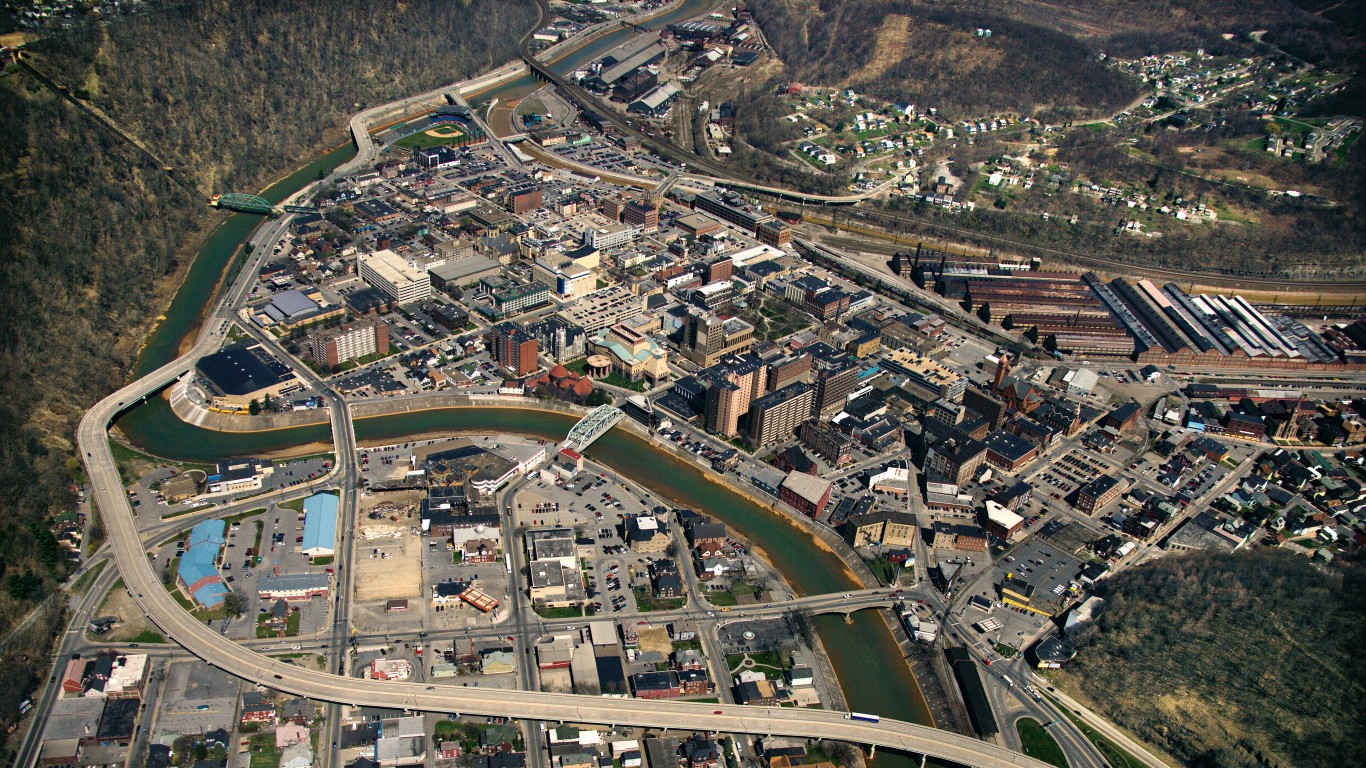
Pennsylvania: Johnstown
> Median household income: $24,294 (state: $59,445)
> Poverty rate: 38.7% (state: 12.8%)
> Median home value: $39,700 (state: $174,100)
> Population: 19,812
Johnstown is a former steel boom town located in Cambria County in the Laurel Mountains of Pennsylvania. Like many Rust Belt cities, the city suffered population and economic decline in the second half of the 20th century as jobs in American steel and coal production dwindled. Since 1920, Johnstowns’ population has fallen from a peak of 67,327 to 19,812 today.
The typical household in Johnstown today earns just $24,294 a year, less than half the $59,445 state median household income and the $60,293 national figure. Some 43.8% of households receive food stamps, more than triple the 13.2% state and 12.2% national recipiency rates.
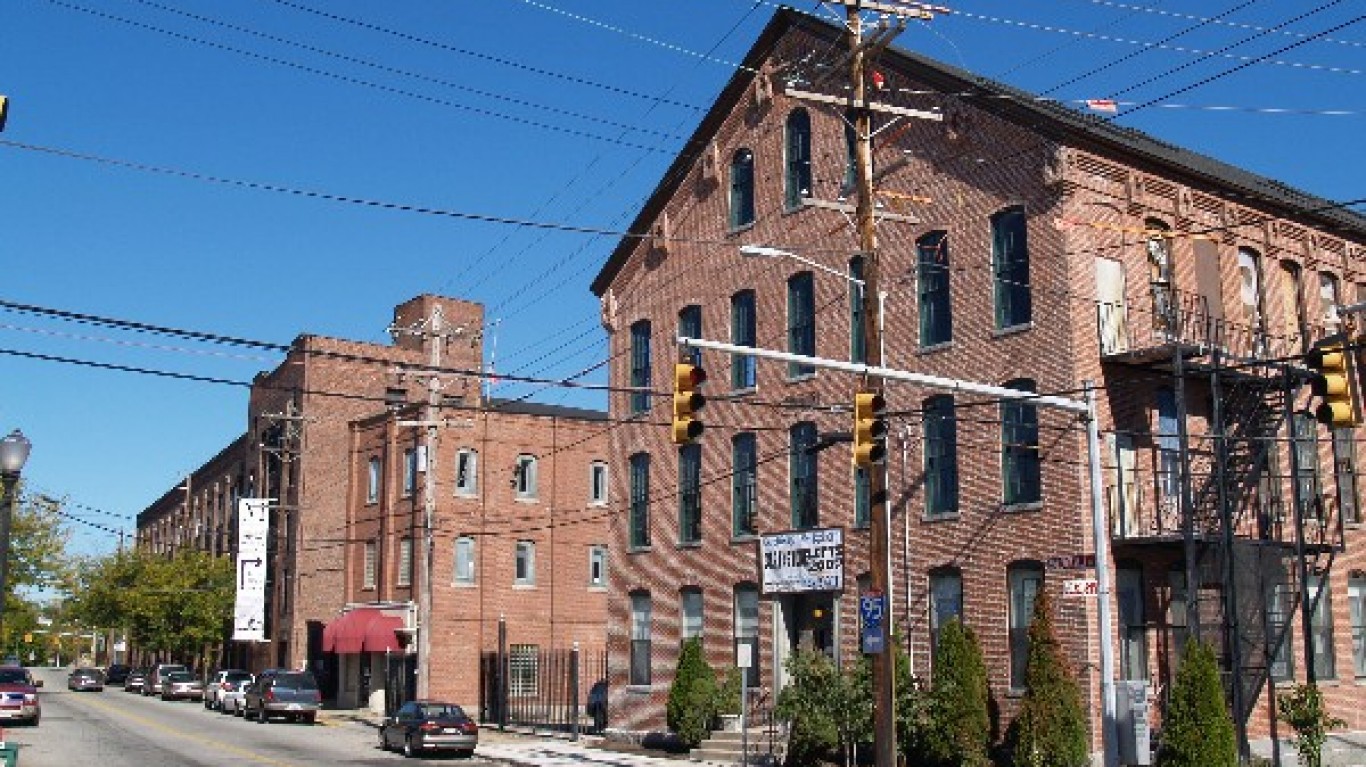
Rhode Island: Central Falls
> Median household income: $31,724 (state: $63,296)
> Poverty rate: 32.8% (state: 13.1%)
> Median home value: $147,800 (state: $249,800)
> Population: 19,382
The typical household in Central Falls, Rhode Island, earns just $31,724 a year, about half the amount the typical Rhode Island household makes annually. Poverty is also far more common in Central Falls than it is across the state. The city’s 32.8% poverty rate is more than double the 13.1% poverty rate statewide.
Incomes tend to rise with educational attainment, and in Central Falls, fewer than one in every 10 adults have a four-year college degree. Across Rhode Island, one in every three adults have a bachelor’s degree.

South Carolina: Dunean
> Median household income: $29,329 (state: $51,015)
> Poverty rate: 20.7% (state: 16.0%)
> Median home value: $82,100 (state: $154,800)
> Population: 3,605
Dunean is a Census-designated place of approximately 3,600 residents located in Greenville County, South Carolina. Founded as a mill town in the early 1900s, Dunean has experienced economic and population decline over the past several decades as employment in manufacturing has dwindled nationwide.
Today, the typical Dunean household earns just $29,329 a year, less than the $51,015 state median household income and less than half the $60,293 national figure. The typical home is worth just $82,100, compared to the state median home value of $154,800 and national median of $204,900.
[in-text-ad-2]
South Dakota: Sisseton
> Median household income: $38,167 (state: $56,499)
> Poverty rate: 21.3% (state: 13.6%)
> Median home value: $71,000 (state: $159,100)
> Population: 2,486
Sisseton is a small city in eastern South Dakota with a median household income of just $38,167, making it the poorest place in the state. The majority of the area’s 2,500 residents identify as Native American, a historically economically disadvantaged group. The lack of economic opportunity in the area is reflected in the widespread poverty. More than one in every five Sisseton residents live below the poverty line, a far larger share than the state’s 13.6% poverty rate.
Tennessee: Harriman
> Median household income: $30,756 (state: $50,972)
> Poverty rate: 20.9% (state: 16.1%)
> Median home value: $97,400 (state: $158,600)
> Population: 6,136
Harriman, a small city of about 6,000 in east-central Tennessee, is the only place in the state where most households earn less than $31,000 a year. The area’s low incomes are reflected by low real estate values. The typical home in Harriman is worth $97,400, about 50% of the value of the typical home across the state as a whole.
As is often the case in the places on this list, Harriman residents are less likely to have a college education than most Americans. Fewer than one in every 10 adults in the city have a bachelor’s degree or higher, compared to more than one in four adults in Tennessee who do.
[in-text-ad]
Texas: Cooper
> Median household income: $31,529 (state: $59,570)
> Poverty rate: 40.9% (state: 15.5%)
> Median home value: $56,300 (state: $161,700)
> Population: 2,213
Cooper, a small city in northeastern Texas, is the only place in the state where most households earn less than $32,000 a year. Incomes tend to go up with educational attainment, and in Cooper, only 15.1% of adults have a bachelor’s degree or higher, about half the comparable statewide share.
Property values in Cooper reflect the area’s low incomes. The typical area home is worth just $56,300 — less than half the value of the typical home in the state of $161,700.
Utah: Ephraim
> Median household income: $39,915 (state: $68,374)
> Poverty rate: 28.0% (state: 10.3%)
> Median home value: $209,000 (state: $256,700)
> Population: 6,987
Ephraim is a city of approximately 7,000 residents located in Sanpete County, Utah. According to Census Bureau data, the typical household in Ephraim earns $39,915 a year, the least of any similarly-sized place in Utah and far less than both the state median household income of $68,374 and the national median of $60,293.
While incomes in Ephraim are the lowest in the state, residents are better off than Americans on average in a number of financial measures. Only 8.5% of households in Ephraim receive food stamps, a larger share than the state recipiency rate of 7.2% but a lower share than the national rate of 12.2%. The typical home in Ephraim is worth $209,000, less than the state median home value of $256,700 yet more than the national figure of $204,900.
Vermont: Fair Haven
> Median household income: $48,367 (state: $60,076)
> Poverty rate: 14.8% (state: 11.2%)
> Median home value: $143,500 (state: $223,700)
> Population: 2,280
The typical household in Vermont earns about $60,000 a year, in line with the national median household income. Despite a similar median income, residents of cities in towns across Vermont are far less likely to be struggling financially than most Americans. In Fair Haven, the poorest town in the state, the median household income is $48,367 — more than the median income in some states including Arkansas, Louisiana, and New Mexico.
Additionally, despite ranking as the poorest town in the state, Fair Haven does not have an especially high poverty rate. Some 14.8% of the area’s 2,280 residents live below the poverty line, well above the 11.2% state poverty rate, but only slightly higher than the 14.1% national rate.
[in-text-ad-2]
Virginia: Farmville
> Median household income: $37,722 (state: $71,564)
> Poverty rate: 33.1% (state: 10.9%)
> Median home value: $174,200 (state: $264,900)
> Population: 8,076
Farmville is a small town of approximately 8,100 residents located in Cumberland and Prince Edward Counties some 50 miles west of Richmond. The typical household in Farmville earns $37,722 a year, nearly half the state median household income of $71,564 and far below the national figure of $60,293.
While those with more education are more likely to have higher-paying jobs, and areas with low income tend to have low educational attainment, a larger share of adults in Farmville have gone to college than the average share nationwide. Some 36.4% of adults in Farmville have a bachelor’s degree, less than the 38.2% state college attainment rate yet far more than the 31.5% national figure.
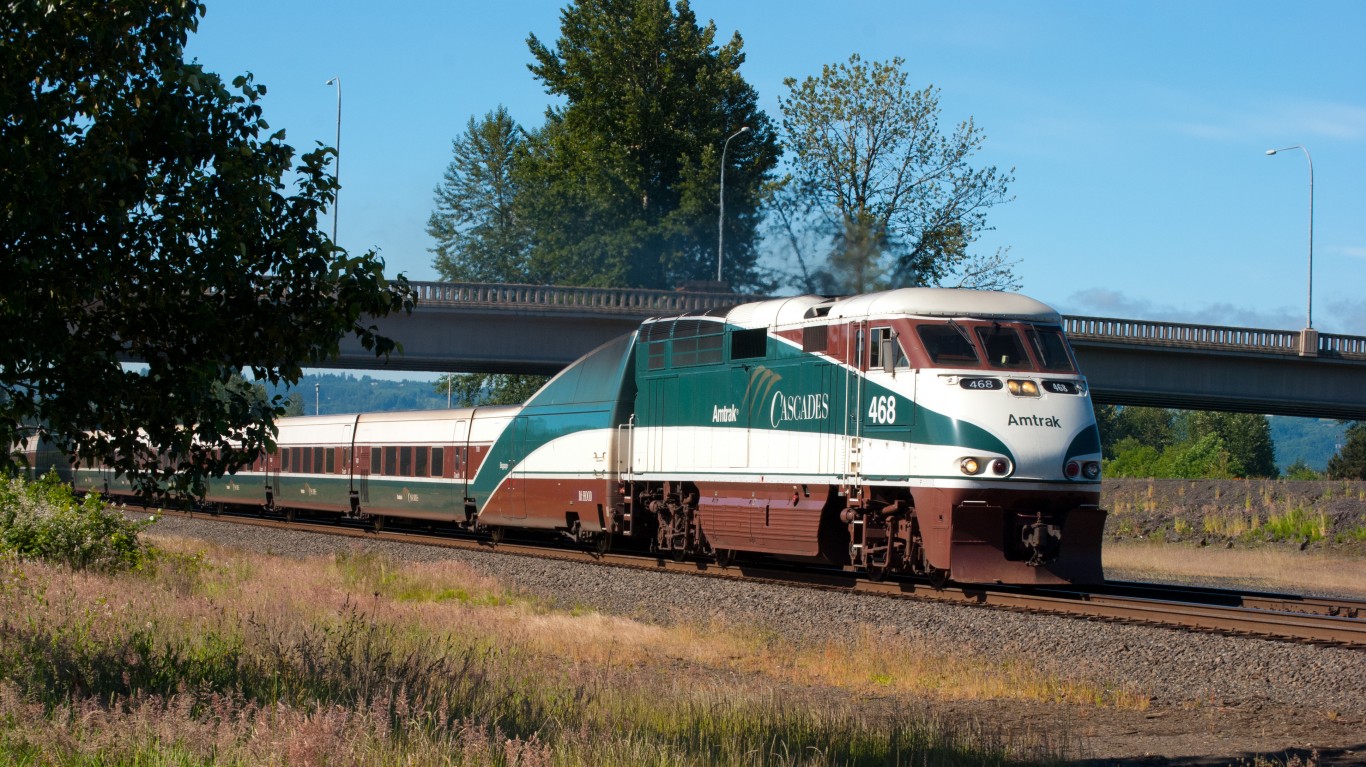
Washington: Kelso
> Median household income: $37,450 (state: $70,116)
> Poverty rate: 27.4% (state: 11.5%)
> Median home value: $133,900 (state: $311,700)
> Population: 11,983
Washington is one of the highest income states in the country. The typical household in Washington earns $70,116 per year, nearly $10,000 more than the typical American household. Not all parts of the state are high income, however. In Kelso, a small city in southwestern Washington, the typical household earns just $37,450 a year. The higher-income parts of the state tend to be concentrated further north, around Seattle.
[in-text-ad]
West Virginia: Kenova
> Median household income: $33,938 (state: $44,921)
> Poverty rate: 19.3% (state: 17.8%)
> Median home value: $75,700 (state: $115,000)
> Population: 3,095
Kenova, a small city of 3,100 residents, is situated on the border of all three states, and its name is a portmanteau of Kentucky, Ohio, and West Virginia. Like many cities in the Rust Belt, Kenova experienced economic and population decline over the past few decades in tandem with the nation’s shrinking coal and steel industries. Since 1970, Kenova’s population has fallen from a peak of 4,860 to 3,095 today.
The typical Kenova household today earns just $33,938 a year, less than the state median household income of $44,921 and the national median of $60,293. The typical home is worth just $75,700, far less than the state median home value of $115,000 and less than half the national median value of $204,900.
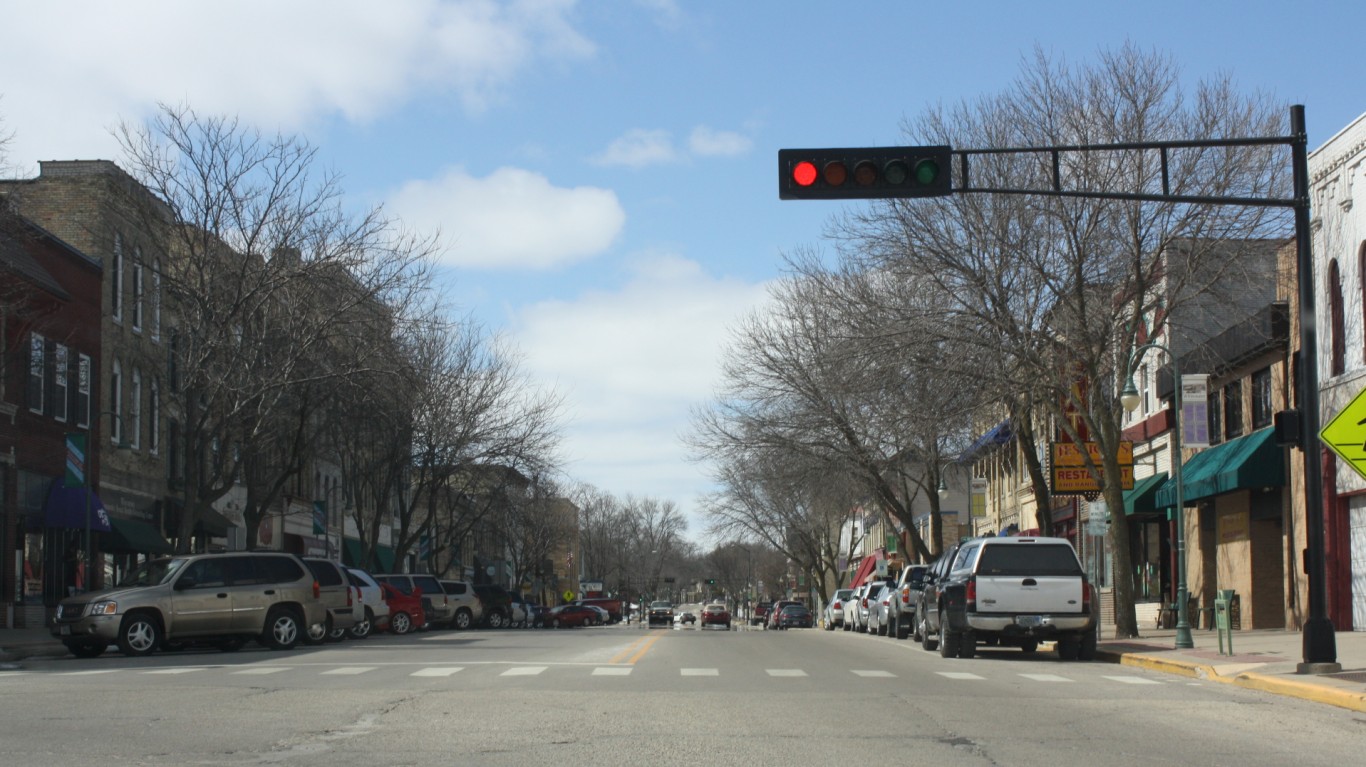
Wisconsin: Whitewater
> Median household income: $34,563 (state: $59,209)
> Poverty rate: 39.0% (state: 11.9%)
> Median home value: $164,500 (state: $173,600)
> Population: 14,766
Whitewater, the poorest small city in Wisconsin, is home to the University of Wisconsin-Whitewater. The concentration of college students, most of whom not working full time, likely skews several socioeconomic measures.
For example, incomes tend to rise with educational attainment, but that is not the case in the city. In Whitewater, 33.5% of adults have a bachelor’s degree or higher, well above the 29.5% of adults across the state, but the median household income in the city of $34,563 is well below the $59,209 statewide median. In general, college towns tend to have lower incomes despite a well-educated population.
Wyoming: Riverton
> Median household income: $51,033 (state: $62,268)
> Poverty rate: 13.3% (state: 11.1%)
> Median home value: $162,600 (state: $213,300)
> Population: 11,069
The typical household in Wyoming earns about $62,268 a year, about $2,000 more than the national median household income of $60,293. Additionally, residents of cities in towns across Wyoming are far less likely to be struggling financially than most Americans. In Riverton, the poorest place with a population between 1,000 and 25,000 in the state, the median household income is $51,033 — more than the median income in some states, including Alabama, South Carolina, and Tennessee.
Additionally, despite ranking as the poorest small city in the state, Riverton’s poverty rate of 13.3% is below the national 14.1% poverty rate.
The #1 Thing to Do Before You Claim Social Security (Sponsor)
Choosing the right (or wrong) time to claim Social Security can dramatically change your retirement. So, before making one of the biggest decisions of your financial life, it’s a smart idea to get an extra set of eyes on your complete financial situation.
A financial advisor can help you decide the right Social Security option for you and your family. Finding a qualified financial advisor doesn’t have to be hard. SmartAsset’s free tool matches you with up to three financial advisors who serve your area, and you can interview your advisor matches at no cost to decide which one is right for you.
Click here to match with up to 3 financial pros who would be excited to help you optimize your Social Security outcomes.
Have questions about retirement or personal finance? Email us at [email protected]!
By emailing your questions to 24/7 Wall St., you agree to have them published anonymously on a673b.bigscoots-temp.com.
By submitting your story, you understand and agree that we may use your story, or versions of it, in all media and platforms, including via third parties.
Thank you for reading! Have some feedback for us?
Contact the 24/7 Wall St. editorial team.
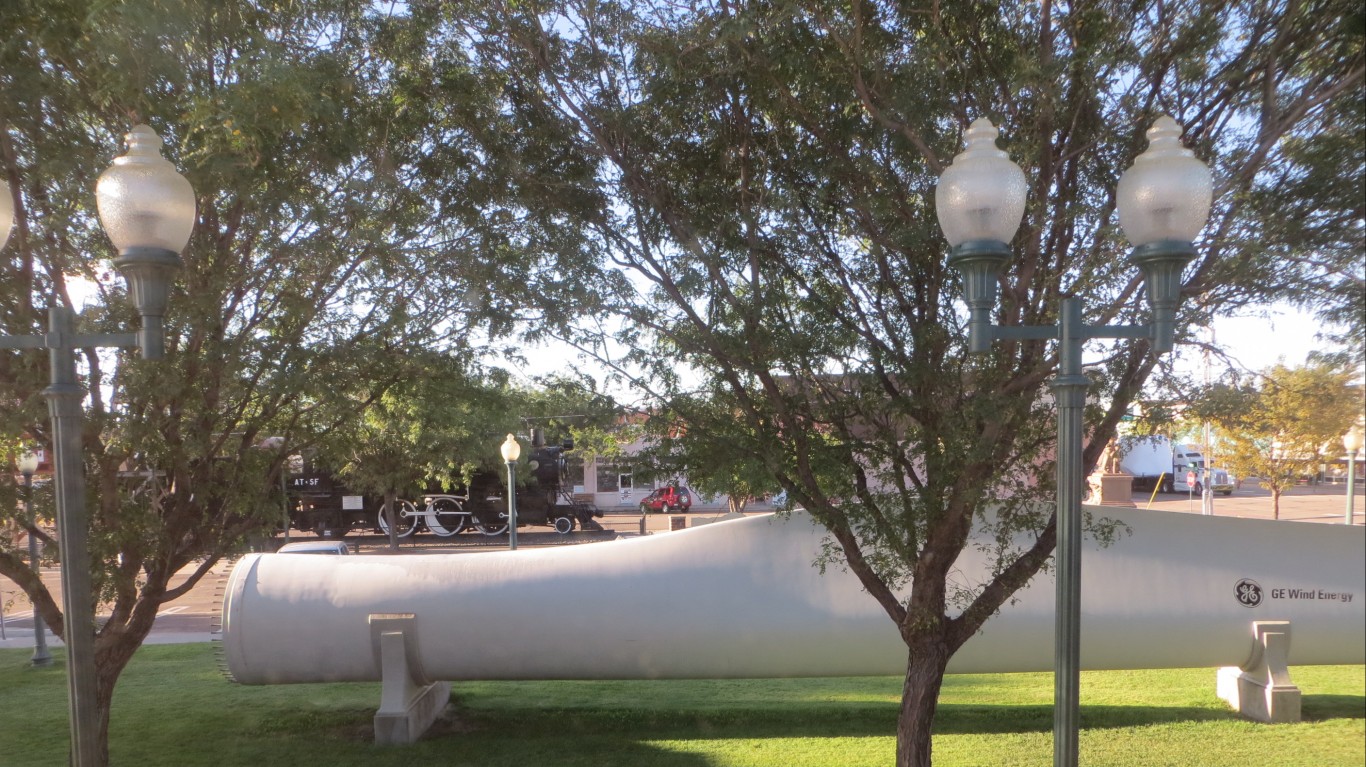
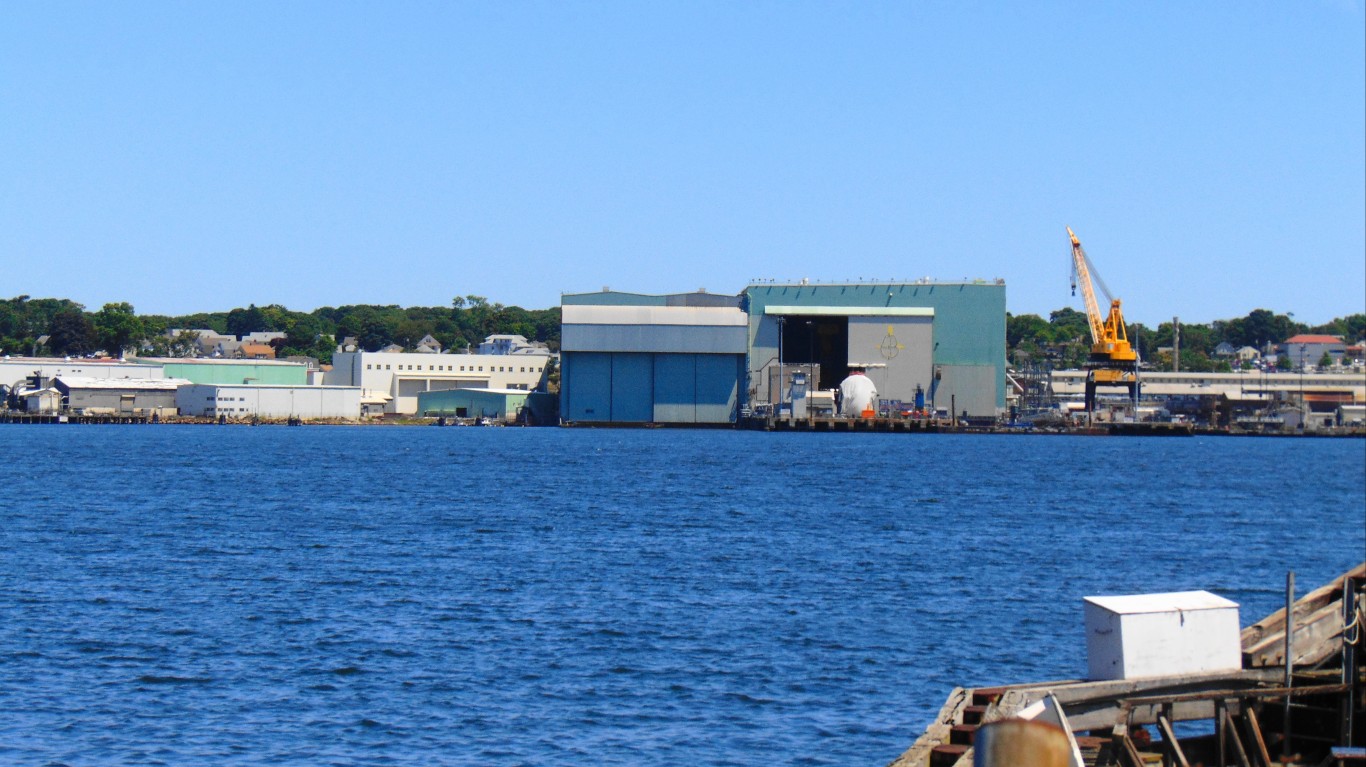

 24/7 Wall St.
24/7 Wall St. 24/7 Wall St.
24/7 Wall St.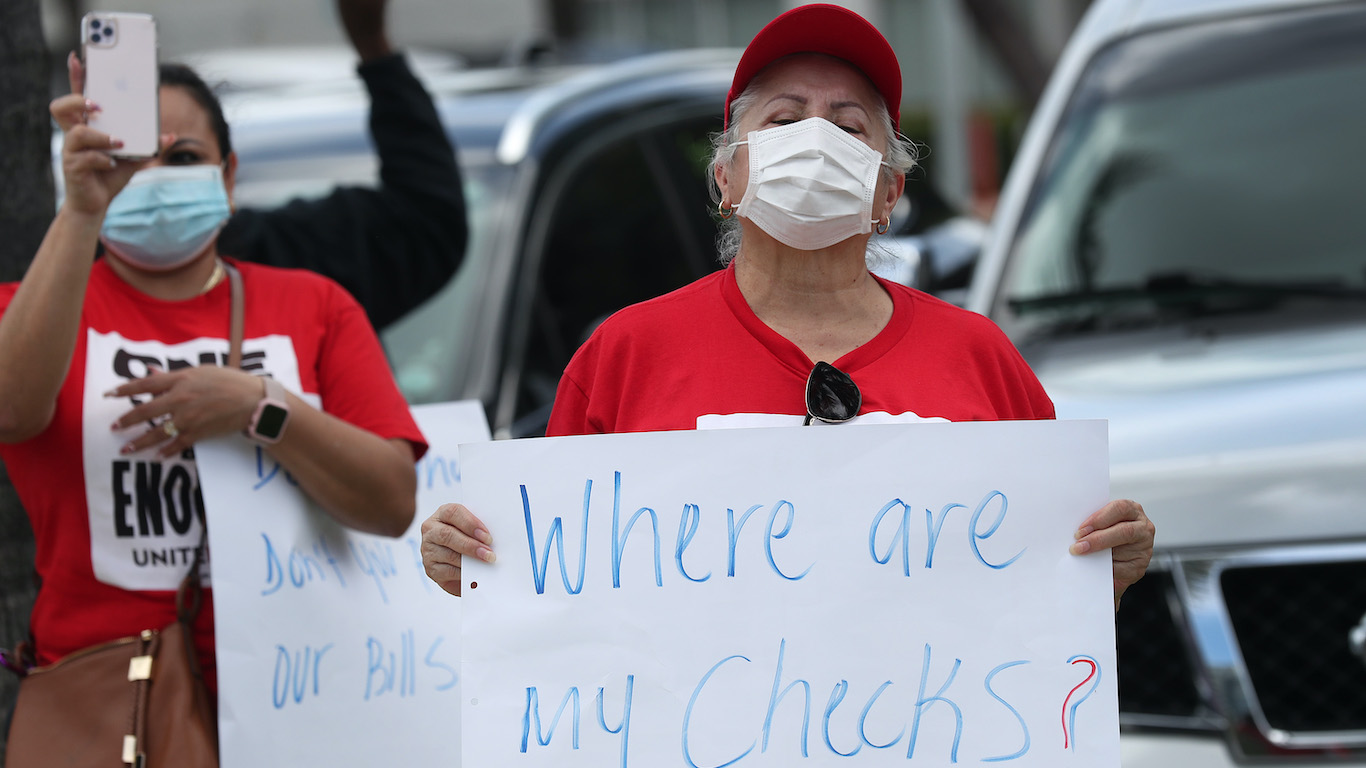 24/7 Wall St.
24/7 Wall St.